Experimental Exploration of Hybrid Nanofluids as Energy-Efficient Fluids in Solar and Thermal Energy Storage Applications
Abstract
1. Introduction
2. Photothermal Performance of Hybrid Nanofluids
| References | HNF (Mixing Ratio)/Base Fluid | φ | Temperature (°C) | Nano-Size (nm) | Stability (Tests, and Surfactants) | Properties | Result |
|---|---|---|---|---|---|---|---|
| Mechiri et al. [65] | Cu-Zn/ground nut (50:50, 75:25,25:75) | 0.1–0.5 vol% | 30–60 | 25 | ZP, surfactant, (2-step) | κ and μ | Highest κ and μ for Cu-Zn/oil (50:50). Newtonian flow for oil and HNFs. |
| Chandran et al. [66] | ZnO-paraffin wax /PG-DIW | 4–16 wt% (ZnO-paraffin) and 2 vol% wt% (HNFs) | 30 | ZnO–30-45 | (2-step) | κ and cp | Maximum enhancements of κ = 10.4%, cp = 18.7%, heat transfer = 13.54%, and coefficient of heat transfer = 15.37%. HNF with 10 wt% paraffin and 2 vol% ZnO yielded κ = 3.5%, cp = 5.1%, and coefficient of heat transfer = 15.37%. |
| Akilu et al. [67] | SiC-CuO/C/EG (8:2) | 0.8–3.13 wt% (0.25–0.99 vol%) | 25–80 | SiC-29, CuO/C-28.5, SiC-CuO/C -12-28 | ZP, DLS, Visual, PVP (2-step) | Rheology, κ, and μ. | At 3.13 wt% and 80 °C, κ and μ were enhanced by 19.3% and 205%, respectively, in comparison with EG. Newtonian behavior was observed for the HNFs at 50–250 s−1. |
| Ghafurian et al. [68] | MWCNT-GNP/seawater (50:50) | 0.001–0.04 wt% | sonication time (30–240) | GNP-40, MWCNT-20-30 | ZP, UV, pH, Gum Arabic (2-step) | Sun intensity, pH, absorbance. | At optimum sonication time of 120 min, the maximum solar evaporation efficiency (61.3%) and evaporation rate (2.89 kg/m2 h), and lowest average particle size were achieved when φ = 0.01 wt% and at the solar intensity of 3.6 suns. |
| Asadi et al. [69] | MgO-MWCNT/EO (80:20) | 0.25–2 wt% | 20–50 | MgO-30nm MWCNT-20-30nm | (2-step) | Κ | Maximum enhancement of 65% at 50 °C and φ = 2 wt%. |
| Gugulothu and Pasam [70] | CNT-MoS2/sesame oil (1:2) | 0.5–3 wt% | 20–50 | CNT-30 MoS2-30 | SDS (15%), Visual (2-step) | κ, μ, and cp | Maximum κ (28.31%), cp (10.98%), and μ were achieved at φ = 3 wt% as compared with sesame oil. |
| Kumar et al. [71] | ZnFe2O4/DW | 0.02–0.5 wt% | 30–80 | - | UV, Visual, CTAB (2-step) | κ and μ. | The highest κ was 11.8% for 0.5 wt at 80 °C. |
| Tong et al. [61] | MWCNT-Fe3O4/ EG-W (20:80) | 0.02 wt% | 20–50 | MW-10-20 Fe3O4-10 | ZP and V | κ | κ = 0.541 W/m°C (Fe3O4 @ 0.2 wt%) and κ = 0.562 W/m°C (MWCNT-Fe3O4 (80:20) @ 0.01 wt%) at 50 °C. |
| Ali et al. [72] | Al2O3-TiO2/5W-30 | 0.1 vol% (0.05% Al2O3 + 0.05% TiO2 + 1.9 wt% oleic) | - | Al2O3-8-12 TiO2-10 | Visual | κ and μ | κ was enhanced by 7–11% relative to the base oil. Non-Newtonian and pseudoplastic behavior were observed. |
| Mendari et al. [73] | Al2O3-CuO/EG-DW (50:50) and EG | 0.001% CuO and 0.04% Al2O3 | - | Al2O3-40 CuO-100 | UV, Visual, pH, SHMP (2-step) | EC, pH, and absorbance | Absorbency and EC of the Al2O3-CuO NFs were close to the sum of the individual NPs in the HNF. EC of EG-DW-based HNFs was higher than EG-based HNFs. |
| Mendari et al. [74] | CuO-Al2O3/DW | 0.001% CuO and 0.04% Al2O3 | - | Al2O3-40 CuO-100 | UV, Visual, pH, SHMP (2-step) | EC, pH, μ, and absorbance | Absorbency and EC of the Al2O3-CuO NFs were close to the sum of the individual NPs in the HNF. EC and absorbance improved with volume fraction. |
| Mendari et al. [75] | Al2O3-CuO/EG-DW (50:50) and DW | 0.001% CuO and 0.04% Al2O3 | - | Al2O3-40 CuO-100 | UV, Visual, pH, SHMP (2-step) | Absorbance and κ | Stability and κ of EG-DW and DW-based Al2O3-CuO NFs were strongly related to sonication time, pH, and surfactant mass fraction. The HNFs were stable at peak absorbance and κ values. |
| Mendari and Alemrajabi [76] | Al2O3-CuO/EG-DW (50:50), EG, and DW | 0.001% CuO and 0.04% Al2O3 | - | Al2O3-40 CuO-100 | UV, Visual, pH, SHMP (2-step) | EC and Absorbance | Absorbency and EC of the Al2O3-CuO NFs were close to the sum of the individual NPs in the HNF. EC of DW-based HNFs was higher than EG-DW and EG-based HNFs. |
| Shin et al. [77] | MWCNT-Fe3O4 (1:1)/EG-W (20:80 wt%) | 0.005–0.2 wt% | - | - | Visual (2-step) | B = 250–750 G, κ, | κ enhanced as φ and magnetic field intensity increased. Maximum κ of 0.562, 0.580, and 0.569 W/m °C for Fe3O4, MWCNT, and MWCNT/Fe3O4 NFs (absence of magnetic field) and 0.583 and 0.59 W/m°C for Fe3O4 and MWCNT/Fe3O4 NFs (under the magnetic intensity of 750 G), respectively, at φ = 0.2 wt% and 50 °C. |
| Harikrishnan et al. [78] | CuO-TiO2 (50:50)/paraffin | 0.25–1 wt% | - | CuO-TiO2- 21 | SDBS, Visual | κ, μ | κ and μ of CuO, TiO2, and CuO-TiO2 NF were enhanced by 51.5%, 32.3%, and 46.81%, and 7.76%, 4.85%, and 6.15%, respectively, at 60 °C. |
| Ali et al. [79] | Cu-GNP/EO (5W-30) | 0.03–0.6 wt% | - | Cu-10-20 GNP-5-10 μm | UV, Visual, Oleic (2 wt%) (2-step) | μ | μ of Cu-GNP/EO NFs enhanced with φ from 54.3–55.2 mm2/s and 9.4–10 mm2/s at 40 °C and 100 °C, respectively. |
| Ali et al. [80] | Al2O3-TiO2 (0.05:0.05 wt%)/5W-30 | 1.5–1.95 wt% and 0.05–0.5 wt% for OA | - | Al2O3- 8-12 TiO2- 10 | UV | μ | μ was 54.06, 54.01 and 51.62 mm2/s and 9.45, 9.42, and 9.23 mm2/s, for EO, EO + OA, and 0.1 wt% Al2O3-TiO2 NF at 40 °C and 100 °C, respectively. The viscosity index of 160, 160, and 163 were obtained for EO, EO + OA, and 0.1 wt% Al2O3-TiO2 NF, respectively. |
| Parameshwaran et al. [81] | Ag-TiO2/organic ester | 0.1–1.5 wt% | - | Ag-TiO2- 10-95 | - | μ and κ | With increasing φ, κ increased from 0.286 W/m K to 0.538 W/m K translating to 10–52% enhancement. μ was enhanced by 0.35–3.8% for the HNFs. Newtonian behavior was demonstrated by the HNFs, |
| Parameshwaran et al. [82] | Cu-TiO2/pristine | 0.02–0.1 wt% | - | - | PVP and ethanol (2-step) | κ | κ was augmented up to 0.08 wt% (0.1926 W/m K) translating to an enhancement of 5.53%. |
| Li et al. [83] | β-CD-TiO2-Ag/ EG-DIW (40:60) | 0.025–0.1 vol% | - | β-CD-TiO2-Ag–40-50 TiO2-Ag–40-50 TiO2 -25-30 | ZP | κ | κ enhanced as φ increased with an improvement of 24.58–42.17% for φ = 0.1 vol% at 20–50 °C. |
| Nithiyanantham et al. [84] | SiO2-Al2O3/binary nitrate salt (eutectic) | 1 wt% | - | SiO2-Al2O3–12, 14, 17 | - | μ, κ, thermal diffusivity | At temperatures of 250–400 °C, the thermal diffusivity, κ, and μ of 35-SiO2-Al2O3 nano-PCM were augmented by 7–14%, 11–19%, and 25–34%, respectively, compared with eutectic-based PCM. |
| Sundar et al. [85] | ND-Co3O4 (67:33)/DW | 0.05–0.15 wt% | 20–60 | - | Visual | μ and κ | For 0.05–0.15 wt% and at a temperature range of 20–60 C, the κ and μ were enhanced by 2.07–15.71% and 6.96–45.83% compared with DW. |
| References | HNF (Mix)/Base Fluid | φ | Optical | Nano-Size (nm) | Stability | Result |
|---|---|---|---|---|---|---|
| Tong et al. [61] | MWCNT-Fe3O4 (20:80–80:20)/EG-W (20:80) | 0.01 wt% (25°) | Absorbance, transmittance, and κ | MW-10–20 Fe3O4-10 | UV, ZP, and Visual (2-step) | SWEA fraction and PTEC efficiency of the HNFs were higher than the Fe3O4 NF. |
| Gulzar et al. [101] | Al2O3-TiO2 (60:40)/Therminol-55 | 0.05–0.5 wt% | Absorbance and transmittance | Al2O3-<80 TiO2-15–25 | Visual (72-D), UV, Oleic (2-step) | At the same irradiation time of 5000 s, the highest temperature improvement (34 °C) was noticed with 0.5 wt% Al2O3-TiO2/therminol-55 NF. |
| Zhou et al. [60] | GO-Au/DW | 0.1–0.3 mg/mL | Absorbance and transmittance | - | UV, ZP, glucose-functionalized (2-step) | The 0.2 mg/mL-GO-Au/DIW NF was the best thermal fluid with peak evaporation rate, enhancement factor, and PTEC efficiency of 1.34 kg/m2 h, 2.35, and 84.1%, respectively. |
| Hjerrild et al. [92] | Ag-SiO2/GL | Absorbance and transmittance | - | UV | Ag-SiO2/GL NF was noticed to be stable under medium-temperature thermal treatment and accelerated high UV irradiation exposure. Ag-SiO2/GL NF is better than Ag-SiO2/W NF in a PV/T collector with high temperature and electrical output. | |
| Shi et al. [59] | Fe3O4-TiO2/DIW | Absorbance and transmittance | Fe3O4-TiO2-50 | UV | The highest thermal receiver efficiency of 76.4% and degradation efficiency of 85% were recorded at 1 sun. Increasing magnetic field intensity enhanced degradation efficiency from 47% (25 mT) to 94% (100 mT). | |
| Zeng and Xuan [93] | MWCNT-SiO2/Ag (4:1–1:4)/DIW | 0.001–0.1% | Absorbance, transmittance, and κ | MWCNT-8–15 | UV, ZP, CTAB | Maximum PTEC efficiency of 97.6% was achieved using HNFs, making them better thermal fluids than MNFs. This was due to the high κ and absorbance values of HNFs. |
| Bhalla et al. [98] | Al2O3-Co3O4/DIW | Al2O3 (20–150 mg/L) Co3O4 (20–80 mg/L) | Absorbance and transmittance | Al2O3-13 Co3O4-10–30 | Triton X-100 (2-step) | The optimum mass fraction of 40 mg/L Al2O3 + 40 mg/L Co3O4 NF yielded the highest temperature rise. Under similar working conditions, the blended NF absorption system was noticed to yield a higher temperature (5.4 °C) than the surface absorption system. |
| Li et al. [104] | SiC-MWCNT (8:2)/EG | 0.01–1 wt% | Absorbance and transmittance | SiC-40 MWCNT-20 | ZP, UV, PVP, (2-step) | The SWEA fraction of 0.5 wt% SiC-MWCNT/EG NF was 99.9% at a penetration distance of 1 cm. With an irradiation time of 10 min, the peak PTEC efficiency was 97.3% using SiC-MWCNT/EG NF with φ = 1 wt%, which was 48.6% more than that of EG. |
| Jin et al. [102] | Cu-Au, Fe3O4-Au, Fe3O4-Cu (1:1), and Fe3O4-Cu-Au (1:1:1)/DIW | 0.06–1 vol% | Absorbance and transmittance | Cu-60–80 | UV | The PTEC efficiency of Cu, Au, Fe3O4, Cu-Au, Fe3O4-Au, Fe3O4-Cu, and Fe3O4-Cu-Au NFs was 75.4%, 76.2%, 61.2%, 80.2%, 70.7%, 76.9%, and 75.5%, respectively, at 1.5 cm optical depth. |
| Qu et al. [95] | CuO-MWCNT/DIW | 0.0015 wt% and 0.005 wt% (MWCNT), 0.01–0.25 wt% (CuO) | Extinction coefficient, absorbance, and transmittance. | MWCNT->50 | UV | Using DIW-based 0.15 wt% CuO + 0.005 wt% MWCNT NF and at an optical distance of 1 cm and irradiation time of 45 min, the SWEA fractions of HNF was 99.2%. The HNFs have improved PTEC efficiency better MNFs. |
| Mehrali et al. [96] | rGO-Ag/DIW | 10–100 mg/L | Extinction coefficient, absorbance, transmittance, κ, and μ. | Ag-25–45 | UV | The PTEC efficiency of 63.3% (80 mg/L), 78% (100 mg/L), and 77% (40 mg/L) was achieved with rGO, rGO-Ag (30), and rGO-Ag (15) NFs, respectively, at 1 sun irradiation intensity and 2000 s irradiation time. The rGO-Ag (15) NF was the best thermal fluid at a collector height of 2 cm. |
| Campus et al. [105] | Au, Ags, Agc, Cu, GOh, GOl, and Ag-GOl/water | 40 and 100 mg/L | Extinction coefficient, absorbance, transmittance, and κ | Au-20, Ags-60, Agc-40–120, Cu-10–100, and Ag-Gol-18 | UV | Under natural solar irradiation (high flux) of 600 s, a higher influence of the NPs shapes on the temperature difference and PTEC efficiency for NFs and HNFs was observed in comparison with artificial irradiation of 1 sun for 3000 s. |
| Kimpton et al. [62] | Ag, SiO2, and Ag-SiO2/W | - | Absorbance and optical density | - | UV (1-step) | The highest temperature and enhancement of 44.1 °C and 102% and 41.7 °C and 91% were observed for Ag and Ag-SiO2 NFs in comparison with water (21.8 °C), respectively. The PTEC efficiency of Ag-SiO2 and Ag NFs was around three-fold more than that of SiO2 NF. |
| Joseph et al. [103] | SiO2/Ag-CuO/DIW | - | κ | CuO-<50 | UV, ZP, SDS (2-step) | Optimal values of 206.3 mg/L, 864.7 mg/L, and 1996.2 mg/L for SiO2/Ag, CuO, and SDS produced good relative thermal conductivity (1.234) and SWEA fraction (82.8%). With the HNF, a peak temperature of 45.7 °C was recorded against 38.8 °C for DIW. |
| Zeiny et al. [97] | Au-Cu (1:1)/DIW | Absorbance | - | UV, DLS, ZP, | With PTEC efficiency of 125%, 72%, and 100% for carbon black (100 mg/L), Au (150 mg/L), and Cu (3000 mg/L) NFs, respectively, the HNFs showed no increase in this variable. Subject to SAR and cost results, the carbon black NF was a suitable thermal fluid. | |
| Wang et al. [100] | FeNi/C (2.19:2.41:95.4)/EG | 5–50 mg/L | Extinction coefficient, absorbance, transmittance, and B = 50 mT. | FeNi/C-8-10 | UV, Visual (2-step) | With solar irradiation time of 3600 s, PTEC efficiency of 47.3–50.4% (without magnetic field) and 49.5–58.7% (magnetic field) for EG-based FeNi/C NFs at 5–50 ppm, as compared with EG (40.4%). |
| Zhu et al. [106] | Ag-Au-ZNG, Au-ZNG, Ag-ZNG/EG | 10–100 ppm | Extinction coefficient, absorbance, and transmittance. | - | UV (2-step) | At an optical depth of 1 cm, concentration of 100 ppm, and solar irradiation of 3000 s, maximum temperature rise, SWEA fraction, and PTEC efficiency of 58.6 °C, 97.1%, and 74.35% were obtained for Ag-Au/ZNGs NF, respectively. |
| He et al. [107] | Ag-TiO2/EG-W | 50–200 ppm | Extinction coefficient, absorbance, and transmittance. | Ag-TiO2-23.6 TiO2-2 | UV | The PTEC efficiency of Ag-TiO2 NF (at 200 ppm) and EG-W (60:40) was 39.9% and 78.1%, respectively, while the PV efficiency was 5.6% for Ag-TiO2 NF. The overall PTEC efficiency of Ag-TiO2 NF was 83.7% (200 ppm) whereas 54.1% was recorded for EG-W (60:40). |
| Wang et al. [99] | ZnO-Au/silicone oil | 0.1–1 mg/mL | Extinction coefficient, absorbance, transmittance, and cp. | Au-13.3, ZnO-0.08 μm | UV (2-step) | The PTEC efficiency of 36%, 49%, and 60% was obtained for ZnO-Au/silicone oil NFs with concentrations of 0.1, 0.5, and 1 mg/mL, respectively. PTEC efficiency improvement of 240% was attained with 1 mg/mL ZnO-Au/silicone oil NF. |
| Chen et al. [86] | Au-Ag/DIW | Au (0.5–2.5 ppm) + Ag (0.15 ppm and 0.5 ppm) | Absorbance. | Au-10 Ag-30 | UV | The PTEC efficiency for Au (1.75 ppm) + Ag (0.15 ppm), Au (1.75 ppm), and Ag (0.15 ppm) NFs was 30.97%, 19.01%, and 11.90% was obtained respectively. |
| Zeng and Xuan [94] | Fe3O4-TIN/DIW | 0.005–0.04% | Extinction coefficient, absorbance, magnetization, and transmittance. | Fe3O4-100 TIN-15 | UV, Visual | With 1 h solar irradiation and volume fraction of 0.005%, the SWEA fraction and temperature of NFs increased in the order of Fe3O4-TiN > Fe3O4 > TiN. The parallel orientation of incident light and magnetic field direction was noticed to produce better results than the perpendicular case, except for the absorbance. |
| Carrillo-Torres et al. [87] | Au-Ag | - | - | - | DLS | For the HNF, maximum photothermal efficiency of 74.68% was obtained while a temperature of 20 °C was recorded after exposing the sample to 15 min of irradiation. |
| Shende and Sundara, [108] | rGO-MWCNT/DIW and EG | - | κ | - | UV, PEG: SLS (2:1), | The thermal and optical properties of rGO-MWNT NF were observed to be enhanced compared with DIW and EG. |
| Chen et al. [88] | CuO-ATO (1:9–9:1)/DIW | 0.02–0.12 vol% | - | - | UV, ZP, pH, sodium citrate (2-step) | Maximum SWEA fraction, temperature change, and PTEC efficiency of 99.6%, 43.6 °C, and 92.5%; 89.5%, 39.8 °C, and 81.3%; and 89.8%, 39.6 °C, and 80.7% were recorded for CuO-ATO, CuO, and ATO NFs, respectively. |
| Xuan et al. [64] | TiO2-Ag/DIW | 0.002–0.15% | - | TiO2-30 Ag-20 | (2-step) | Absorbed energy, temperature, and thermal efficiency of 57.89, 390.88, and 413.36 W/m2; 60.21 °C, 66.65 °C, and 66.93 °C; and 16.07%, 20.86%, and 20.9% were obtained for TiO2, Ag, and TiO2-Ag NFs, respectively. |
| Shin et al. [77] | MWCNT-Fe3O4 (1:1)/EG-W (20:80 wt%) | 0.005–0.2 wt% | Transmittance, B = 250–750 G, and κ | - | Visual (2-step) | The temperature and PTEC efficiency of 0.2 wt% MWCNT-Fe3O4 NF was 45 °C and 32% (without magnetic field) and 60 °C and 45% (with the magnetic field of 750 G). Under 750 G magnetic intensity, the total stored energy of 0.2 wt% MWCNT/Fe3O4 NF was enhanced by 61.5%. |
| Li et al. [104] | SiC-MWCNT (80:20)/EG | 0.01–1 wt% | Extinction coefficient, absorbance, and transmittance. | SiC- 40 MWCNT- 20 | ZP, UV, Visual, PVP-K30, (2-step) | At a maximum SWEA fraction of over 99.9%, the temperature difference of close to 110 °C, and PTEC efficiency of 97.3% were obtained with 1 wt% SiC-MWCNT/EG NF. |
3. Solar Energy Application of Hybrid Nanofluids
3.1. Direct Absorption Solar Collectors
3.2. Flat Plate Solar Collectors
3.3. Parabolic Solar Collectors
3.4. Vacuum Tube Solar Collectors
3.5. Photovoltaic-Thermal Solar Collectors
4. Thermal Energy Storage Application of Hybrid Nanofluids
| References | HNF (Mix)/Base Fluid | φ | Application | Nano-Size (nm) | Stability | Thermal Properties | Result |
|---|---|---|---|---|---|---|---|
| Liu et al. [111] | GO-CNT (3:1, 1:1, and 3:1)/ MEPCM/DIW | 0.1–0.6 wt% | GO-CNT-50 | ZP, UV, SDS, (2-step) | Κ | The latent heat of GO-CNT (3:1, 1:1, and 1:3)/MEPCM-DIW NFs was slightly reduced compared with MEPCM alone. The HNF with a mixing ratio of 3:1 yielded the highest κ enhancement (195%). | |
| Harikrishnan et al. [124] | Ni-ZnO/oleic acid | 0.3–1.2 wt% | Ni-ZnO-36 | SDBS (2-step) | Κ | The time taken by melting (900 s–1280s) and solidification (990 s–1385s) processes was lower for oleic acid-Ni-ZnO NFs than oleic acid. Oleic acid-Ni-ZnO NFs recorded κ enhancement of 25.43–87.27% relative to oleic acid. | |
| Shao et al. [128] | TiO2-NT and TiO2-NPT (0:100–100:0)/DIW | 0.1–0.3 wt% | TiO2-32 NT-10 and NPT-50–80 | (2-step) | θc and κ | The enhancement κ by 54.91% and 56.42% for DIW-based TiNTs-TiNPTs NFs was responsible for the reduction of supercooling temperature and solidification time by 4.97 °C and 5.27 °C, and 54.91% and 56.42%, respectively, as compared with TiNT and TiNPT NFs. | |
| Abdullah et al. [129] | CuTsPc-TiO2/water | - | - | - | - | The capacitive and resistive sensitivity of TiO2-CuTsPc NF was 5.548 nF/°C and 0.098 kΩ/°C while that of CuTsPc was 1.064 nF/°C and 0.23 kΩ/°C. This revealed the capacitance switching of the device. | |
| Zeng et al. [126] | Sn-SiO2/Ag | - | DASC | SiO2-10 Sn-68 | UV, PVP (2-step) | - | The thermal storage efficiency of Sn in Sn/SiO2 and Sn/SiO2/Ag NPs was 99.0% and 98.4%, respectively. Under 200 heating–cooling cycles, 227.0 °C and 127.8 °C and 35.7 J/g and 29.2 J/g were recorded as the melting and freezing temperatures and enthalpies, respectively. |
| Chieruzzi et al. [125] | SiO2-Al2O3 (82:18)/NaNO3- KNO3 (60:40) | 0.5–1.5 wt% | CSP | SiO2-Al2O3- 2–200 SiO2- 7 Al2O3- 13 | (2-step) | cp, heat of fusion, MT, ST, storage energy | 0.1 wt% binary salt-based SiO2-Al2O3 NF improved the specific heat by 57% (solid phase) and 22% (liquid phase), and reduced melting temperature by 8 °C and solidification temperature by 10 °C. HNF was better than SiO2, Al2O3, and TiO2 NFs. |
| Chieruzzi et al. [127] | SiO2-Al2O3 (82:18)/NaNO3- KNO3 (60:40) | 1 wt% | CSP | SiO2-Al2O3-2–200 SiO2- 7 Al2O3- 13 | (2-step) | cp, heat of fusion, MT, ST, storage energy | The cp of SiO2-Al2O3/binary salt NF was improved by 52.1% (solid phase) and 18.6% (liquid phase), the heat of fusion was enhanced by 1.5–7.4%, and the stored energy was augmented by 13.5% in comparison with the binary salt. |
| Harikrishnan et al. [78] | CuO-TiO2 (50:50)/paraffin | 0.25–1 wt% | - | CuO-TiO2- 21 | SDBS, Visual | κ, μ, MT, FT, MLH, FLH | FLH and MLH of 1 wt% CuO-TiO2 NF were reduced by 1.83% and 2.27%, respectively, compared with the base fluid. A reduction of 29.8% (melting time) and 28.7% (freezing time) was achieved using 1 wt% CuO-TiO2 NF. |
| Vaka et al. [130] | GO-TiO2/hybrid eutectic salt | 0.01–0.1 wt% | CSP | - | - | The cp of GO-TiO2/eutectic material was improved by 9.8%, 19.1%, and 19.6% for 0.01, 0.05, and 0.1 wt%, compared with the hybrid eutectic salt. The highest cp, heat flow, and latent heat were attained with 0.05 wt% GO-TiO2/eutectic material. | |
| Parameshwaran et al. [81] | Ag-TiO2/organic ester | 0.1–1.5 wt% | Buildings internal walls | Ag-TiO2- 10–95 | Ethanol (2-step) | - | The duration of the onset of melting and freezing for the Ag-TiO2 NFs declined by 1.7–8.5% and 5.1–23.9%, respectively, compared with pure organic ester. After 1000 cycles, the latent heat capacity of the 0.8 wt% HNF was reduced by 1.00–9.18% (melting) and 1.74–7.38% (freezing). |
| Parameshwaran et al. [82] | Cu-TiO2/pristine | 0.02–0.1 wt% | Buildings internal walls | - | PVP and ethanol (2-step) | - | Adding Cu-TiO2 nanomaterial into pristine enhanced κ up to 0.08 wt% (0.1926 W/m K). The average enthalpy of latent heat of pristine-based Cu-TiO2 nanomaterials was 190.03 J/g (freezing) and 195.03 J/g (melting), similar to that of pristine. |
| Li et al. [83] | β-CD-TiO2-Ag/EG-DIW (40:60) | 0.025–0.1 vol% | Cold energy storage systems | β-CD-TiO2-Ag–40–50 TiO2-Ag–40–50 TiO2 -25–30 | ZP (2-step) | - | The 0.1 vol% β-CD-TiO2-Ag PCM yielded higher melting phase change temperature, supercooling temperature, freezing phase change temperature, freezing phase enthalpy, and melting phase enthalpy and lower supercooling degree and total freezing time than the pure PCM. |
| Nithiyanantham et al. [84] | SiO2-Al2O3/binary nitrate salt (eutectic) | 1 wt% | CSP | SiO2-Al2O3–12, 14, 17 | - | μ, κ, thermal diffusivity | At temperatures of 250 °C–400 °C, the thermal diffusivity of 10-SiO2-Al2O3 nano-PCM, 20-SiO2-Al2O3 nano-PCM, and 35-SiO2-Al2O3 nano-PCM were improved by −8%–−4%, 0%–−2%, and 7–14%, respectively, compared with eutectic-based PCM. |
| Sharma et al. [131] | CoZnFe2O4/paraffin | 0.1 wt% | - | CoZnFe2O4- 30-40 | - | - | The discharging of the paraffin wax took 100 min (33 °C) with CoZnFe2O4 NF and 130 min (35 °C) engaging DW. The charging and discharging time declined by 25% and 23%, respectively, for the paraffin wax using CoZnFe2O4 NF. |
5. Challenge and Research Outlook
6. Conclusions
Author Contributions
Funding
Data Availability Statement
Acknowledgments
Conflicts of Interest
Nomenclature
| ZP—Zeta potential | UV—ultraviolet |
| wt%—percent weight | PVP—polyvinylpyrrolidone |
| EG—ethylene glycol | SDBS—sodium dodecyl benzene sulfonate |
| DLS—dynamic light scattering | SDS—sodium dodecyl sulfate |
| PG—polyethene glycol | SLS—sodium lauryl sulfate |
| SHMP—sodium hexa meta phosphate | CTAB—centrimonium bromide |
| cp—specific heat capacity, kJ/kg K | DASC—direct absorption solar collector |
| DIW—deionized water | DW—distilled water |
| EC—extinction coefficient | EGR—entropy generation rate, W/K |
| EO—engine oil | f— friction factor |
| FLH—freezing latent heat, kJ/kg | FPSC—flat plate solar collector |
| FT or ST—freezing or solidification temperature, °C | h—heat transfer coefficient, W/m2 K |
| HNF—hybrid nanofluid | HNP—hybrid nanoparticles |
| MLH—melting latent heat, kJ/kg | MNF—mono nanofluid |
| MT—meting temperature, °C | NF—nanofluid |
| NP—nanoparticles | PCM—phase change materials |
| PEC—performance evaluation criteria | PTEC—photo-thermal energy conversion |
| PV/T—photovoltaic-thermal | SAR—specific absorption rate, W/μl |
| SWEA—solar weighted energy | W—water |
| Greek symbols | |
| φ—volume or weight concentration or fraction | κ—thermal conductivity, W/m K |
| ρ—density, kg/m3 | θc—contact angle, ° |
| μ—viscosity, mPas | |
References
- Giwa, S.O.; Adama, O.O.; Akinyemi, O.O. Baseline black carbon emissions for gas flaring in the Niger Delta region of Nigeria. J. Nat. Gas Sci. Eng. 2014, 20, 373–379. [Google Scholar] [CrossRef]
- Giwa, S.O.; Nwaokocha, C.N.; Kuye, S.I.; Adama, K.O. Gas flaring attendant impacts of criteria and particulate pollutants: A case of Niger Delta region of Nigeria. J. King Saud Univ.-Eng. Sci. 2019, 31, 209–217. [Google Scholar] [CrossRef]
- Giwa, S.O.; Nwaokocha, C.N.; Layeni, A.T. Inventory of kiln stacks emissions and health risk assessment: Case of a cement industry in Southwest Nigeria. Afr. J. Sci. Technol. Innov. Dev. 2019, 11, 299–312. [Google Scholar] [CrossRef]
- Vavrek, R.; Chovancová, J. Assessment of economic and environmental energy performance of EU countries using CV-TOPSIS technique. Ecol. Indic. 2019, 106, 105519. [Google Scholar] [CrossRef]
- Vanaki, S.; Ganesan, P.; Mohammed, H. Numerical study of convective heat transfer of nanofluids: A review. Renew. Sustain. Energy Rev. 2016, 54, 1212–1239. [Google Scholar] [CrossRef]
- Ganvir, R.; Walke, P.; Kriplani, V. Heat transfer characteristics in nanofluid—A review. Renew. Sustain. Energy Rev. 2016, 75, 451–460. [Google Scholar] [CrossRef]
- Giwa, S.O.; Sharifpur, M.; Ahmadi, M.H.; Meyer, J.P. Magnetohydrodynamic convection behaviours of nanofluids in non-square enclosures: A comprehensive review. Math. Methods Appl. Sci. 2020. [Google Scholar] [CrossRef]
- Giwa, S.O.; Sharifpur, M.; Ahmadi, M.H.; Meyer, J.P. A review of magnetic field influence on natural convection heat transfer performance of nanofluids in square cavities. J. Therm. Anal. Calorim. 2020, 145, 2581–2623. [Google Scholar] [CrossRef]
- Ambreen, T.; Kim, M.-H. Heat transfer and pressure drop correlations of nanofluids: A state of art review. Renew. Sustain. Energy Rev. 2018, 91, 564–583. [Google Scholar] [CrossRef]
- Gupta, M.; Singh, V.; Kumar, S.; Kumar, S.; Dilbaghi, N.; Said, Z. Up to date review on the synthesis and thermophysical properties of hybrid nanofluids. J. Clean. Prod. 2018, 190, 169–192. [Google Scholar] [CrossRef]
- Masuda, H.; Ebata, A.; Teramae, K.; Hishinuma, N. Alteration of Thermal Conductivity and Viscosity of Liquid by Dispersing Ultra-Fine Particles. Netsu Bussei 1993, 7, 227–233. [Google Scholar] [CrossRef]
- Choi, S.U.S.; Eastman, J.A. Enhancing thermal conductivity of fluids with nanoparticles. ASME Int. Mech. Eng. Congr. Expo. 1995, 66, 99–105. [Google Scholar] [CrossRef]
- Chopkar, M.; Kumar, S.; Bhandari, D.; Das, P.; Manna, I. Development and characterization of Al2Cu and Ag2Al nanoparticle dispersed water and ethylene glycol based nanofluid. Mater. Sci. Eng. B Solid-State Mater. Adv. Technol. 2007, 139, 141–148. [Google Scholar] [CrossRef]
- Jana, S.; Salehi-Khojin, A.; Zhong, W.-H. Enhancement of fluid thermal conductivity by the addition of single and hybrid nano-additives. Thermochim. Acta 2007, 462, 45–55. [Google Scholar] [CrossRef]
- Ahlatli, S.; Mare, T.; Estelle, P.; Doner, N. Thermal Performance of Carbon Nanotube Nanofluids in Solar Microchannel Collectors: An Experimental Study. Int. J. Technol. 2016, 7, 219–226. [Google Scholar] [CrossRef]
- Ghodsinezhad, H.; Sharifpur, M.; Meyer, J.P. Experimental investigation on cavity flow natural convection of Al2O3—water nanofluids. Int. Commun. Heat Mass Transf. 2016, 76, 316–324. [Google Scholar] [CrossRef]
- Choudhary, S.; Sachdeva, A.; Kumar, P. Investigation of the stability of MgO nanofluid and its effect on the thermal performance of flat plate solar collector. Renew. Energy 2020, 147, 1801–1814. [Google Scholar] [CrossRef]
- Dehaj, M.S.; Mohiabadi, M.Z. Experimental investigation of heat pipe solar collector using MgO nanofluids. Sol. Energy Mater. Sol. Cells 2019, 191, 91–99. [Google Scholar] [CrossRef]
- Garbadeen, I.; Sharifpur, M.; Slabber, J.; Meyer, J. Experimental study on natural convection of MWCNT-water nanofluids in a square enclosure. Int. Commun. Heat Mass Transf. 2017, 88, 1–8. [Google Scholar] [CrossRef]
- Solomon, A.B.; Daniel, V.A.; Ramachandran, K.; Pillai, B.; Singh, R.R.; Sharifpur, M.; Meyer, J. Performance enhancement of a two-phase closed thermosiphon with a thin porous copper coating. Int. Commun. Heat Mass Transf. 2017, 82, 9–19. [Google Scholar] [CrossRef]
- Lou, J.-F.; Zhang, H.; Wang, R. Experimental investigation of graphite nanolubricant used in a domestic refrigerator. Adv. Mech. Eng. 2015, 7, 1–9. [Google Scholar] [CrossRef]
- Ho, C.; Chen, W.-C.; Yan, W.-M.; Amani, P. Contribution of hybrid Al2O3-water nanofluid and PCM suspension to augment thermal performance of coolant in a minichannel heat sink. Int. J. Heat Mass Transf. 2018, 122, 651–659. [Google Scholar] [CrossRef]
- Osman, S.; Sharifpur, M.; Meyer, J.P. Experimental investigation of convection heat transfer in the transition flow regime of aluminium oxide-water nanofluids in a rectangular channel. Int. J. Heat Mass Transf. 2019, 133, 895–902. [Google Scholar] [CrossRef]
- Yan, S.-R.; Golzar, A.; Sharifpur, M.; Meyer, J.P.; Liu, D.-H.; Afrand, M. Effect of U-shaped absorber tube on thermal-hydraulic performance and efficiency of two-fluid parabolic solar collector containing two-phase hybrid non-Newtonian nanofluids. Int. J. Mech. Sci. 2020, 185, 105832. [Google Scholar] [CrossRef]
- Khan, A.; Ali, H.M.; Nazir, R.; Ali, R.; Munir, A.; Ahmad, B.; Ahmad, Z. Experimental investigation of enhanced heat transfer of a car radiator using ZnO nanoparticles in H2O–ethylene glycol mixture. J. Therm. Anal. Calorim. 2019, 138, 3007–3021. [Google Scholar] [CrossRef]
- Palaniappan, B.; Ramasamy, V. Thermodynamic analysis of fly ash nanofluid for automobile (heavy vehicle) radiators. J. Therm. Anal. Calorim. 2019, 136, 223–233. [Google Scholar] [CrossRef]
- Ali, M.K.A.; Xianjun, H.; Mai, L.; Qingping, C.; Turkson, R.F.; Bicheng, C. Improving the tribological characteristics of piston ring assembly in automotive engines using Al2O3 and TiO2 nanomaterials as nano-lubricant additives. Tribol. Int. 2016, 103, 540–554. [Google Scholar] [CrossRef]
- Nam, J.S.; Lee, P.-H.; Lee, S.W. Experimental characterization of micro-drilling process using nanofluid minimum quantity lubrication. Int. J. Mach. Tools Manuf. 2011, 51, 649–652. [Google Scholar] [CrossRef]
- Hwang, Y.; Park, H.; Lee, J.; Jung, W. Thermal conductivity and lubrication characteristics of nanofluids. Curr. Appl. Phys. 2006, 6, 67–71. [Google Scholar] [CrossRef]
- Kiani, M.; Ansari, M.; Arshadi, A.A.; Houshfar, E.; Ashjaee, M. Hybrid thermal management of lithium-ion batteries using nanofluid, metal foam, and phase change material: An integrated numerical–experimental approach. J. Therm. Anal. Calorim. 2020, 141, 1703–1715. [Google Scholar] [CrossRef]
- Zarei, M.J.; Bazai, H.; Sharifpur, M.; Mahian, O.; Shabani, B. The Effects of Fin Parameters on the Solidification of PCMs in a Fin-Enhanced Thermal Energy Storage System. Energies 2020, 13, 198. [Google Scholar] [CrossRef]
- Navarrete, N.; Mondragón, R.; Wen, D.; Navarro, M.E.; Ding, Y.; Juliá, J.E. Thermal energy storage of molten salt –based nanofluid containing nano-encapsulated metal alloy phase change materials. Energy 2019, 167, 912–920. [Google Scholar] [CrossRef]
- Esmaeilzadeh, F.; Teja, A.S.; Bakhtyari, A. The thermal conductivity, viscosity, and cloud points of bentonite nanofluids with n-pentadecane as the base fluid. J. Mol. Liq. 2020, 300, 112307. [Google Scholar] [CrossRef]
- Salehnezhad, L.; Heydari, A.; Fattahi, M. Experimental investigation and rheological behaviors of water-based drilling mud contained starch-ZnO nanofluids through response surface methodology. J. Mol. Liq. 2019, 276, 417–430. [Google Scholar] [CrossRef]
- William, J.K.M.; Ponmani, S.; Samuel, R.; Nagarajan, R.; Sangwai, J.S. Effect of CuO and ZnO nanofluids in xanthan gum on thermal, electrical and high pressure rheology of water-based drilling fluids. J. Pet. Sci. Eng. 2014, 117, 15–27. [Google Scholar] [CrossRef]
- Kim, J.H.; Jung, C.W.; Kang, Y.T. Mass transfer enhancement during CO2 absorption process in methanol/Al2O3 nanofluids. Int. J. Heat Mass Transf. 2014, 76, 484–491. [Google Scholar] [CrossRef]
- Irani, V.; Maleki, A.; Tavasoli, A. CO2 absorption enhancement in graphene-oxide/MDEA nanofluid. J. Environ. Chem. Eng. 2019, 7, 102782. [Google Scholar] [CrossRef]
- Ali, M.; Sahito, M.F.; Jha, N.K.; Arain, Z.-U.; Memon, S.; Keshavarz, A.; Iglauer, S.; Saeedi, A.; Sarmadivaleh, M. Effect of nanofluid on CO2-wettability reversal of sandstone formation; implications for CO2 geo-storage. J. Colloid Interface Sci. 2020, 559, 304–312. [Google Scholar] [CrossRef]
- Chen, W.; Zou, C.; Li, X.; Liang, H. Application of recoverable carbon nanotube nanofluids in solar desalination system: An experimental investigation. Desalination 2019, 451, 92–101. [Google Scholar] [CrossRef]
- Seyednezhad, M.; Sheikholeslami, M.; Ali, J.A.; Shafee, A.; Nguyen, T.K. Nanoparticles for water desalination in solar heat exchanger. J. Therm. Anal. Calorim. 2020, 139, 1619–1636. [Google Scholar] [CrossRef]
- Parsa, S.M.; Rahbar, A.; Koleini, M.; Aberoumand, S.; Afrand, M.; Amidpour, M. A renewable energy-driven thermoelectric-utilized solar still with external condenser loaded by silver/nanofluid for simultaneously water disinfection and desalination. Desalination 2020, 480, 114354. [Google Scholar] [CrossRef]
- Guo, J.; Barber, G.C.; Schall, D.J.; Zou, Q.; Jacob, S.B. Tribological properties of ZnO and WS2 nanofluids using different surfactants. Wear 2017, 382–383, 8–14. [Google Scholar] [CrossRef]
- Gao, T.; Li, C.; Zhang, Y.; Yang, M.; Jia, D.; Jin, T.; Hou, Y.; Li, R. Dispersing mechanism and tribological performance of vegetable oil-based CNT nanofluids with different surfactants. Tribol. Int. 2019, 131, 51–63. [Google Scholar] [CrossRef]
- Shen, B.; Shih, A.J.; Tung, S.C. Application of Nanofluids in Minimum Quantity Lubrication Grinding. Tribol. Trans. 2008, 51, 730–737. [Google Scholar] [CrossRef]
- Alnarabiji, M.S.; Yahya, N.; Nadeem, S.; Adil, M.; Baig, M.K.; Ben Ghanem, O.; Azizi, K.; Ahmed, S.; Maulianda, B.; Klemeš, J.J.; et al. Nanofluid enhanced oil recovery using induced ZnO nanocrystals by electromagnetic energy: Viscosity increment. Fuel 2018, 233, 632–643. [Google Scholar] [CrossRef]
- Hendraningrat, L.; Li, S.; Torsæter, O. A coreflood investigation of nanofluid enhanced oil recovery. J. Pet. Sci. Eng. 2013, 111, 128–138. [Google Scholar] [CrossRef]
- Li, R.; Jiang, P.; Gao, C.; Huang, F.; Xu, R.; Chen, X. Experimental Investigation of Silica-Based Nanofluid Enhanced Oil Recovery: The Effect of Wettability Alteration. Energy Fuels 2017, 31, 188–197. [Google Scholar] [CrossRef]
- Zaibudeen, A.; Philip, J. Temperature and pH sensor based on functionalized magnetic nanofluid. Sensors Actuators B Chem. 2018, 268, 338–349. [Google Scholar] [CrossRef]
- Zaibudeen, A.; Philip, J. Magnetic nanofluid based non-enzymatic sensor for urea detection. Sensors Actuators B Chem. 2017, 255, 720–728. [Google Scholar] [CrossRef]
- Soares, M.C.P.; Rodrigues, M.S.; Schenkel, E.A.; Perli, G.; Silva, W.H.A.; Gomes, M.K.; Fujiwara, E.; Suzuki, C.K. Evaluation of Silica Nanofluids in Static and Dynamic Conditions by an Optical Fiber Sensor. Sensors 2020, 20, 707. [Google Scholar] [CrossRef]
- Jha, N.; Ramaprabhu, S. Synthesis and Thermal Conductivity of Copper Nanoparticle Decorated Multiwalled Carbon Nanotubes Based Nanofluids. J. Phys. Chem. C 2008, 112, 9315–9319. [Google Scholar] [CrossRef]
- Sundar, L.S.; Ramana, E.V.; Graça, M.; Singh, M.K.; Sousa, A.C. Nanodiamond-Fe3O4 nanofluids: Preparation and measurement of viscosity, electrical and thermal conductivities. Int. Commun. Heat Mass Transf. 2016, 73, 62–74. [Google Scholar] [CrossRef]
- Sundar, L.S.; Shusmitha, K.; Singh, M.K.; Sousa, A.C. Electrical conductivity enhancement of nanodiamond–nickel (ND–Ni) nanocomposite based magnetic nanofluids. Int. Commun. Heat Mass Transf. 2014, 57, 1–7. [Google Scholar] [CrossRef]
- Akilu, S.; Baheta, A.T.; Said, M.A.M.; Minea, A.A.; Sharma, K. Properties of glycerol and ethylene glycol mixture based SiO2-CuO/C hybrid nanofluid for enhanced solar energy transport. Sol. Energy Mater. Sol. Cells 2018, 179, 118–128. [Google Scholar] [CrossRef]
- Giwa, S.O.; Momin, M.; Nwaokocha, C.N.; Sharifpur, M.; Meyer, J.P. Influence of nanoparticles size, per cent mass ratio, and temperature on the thermal properties of water-based MgO–ZnO nanofluid: An experimental approach. J. Therm. Anal. Calorim. 2020, 143, 1063–1079. [Google Scholar] [CrossRef]
- Giwa, S.O.; Sharifpur, M.; Goodarzi, M.; Alsulami, H.; Meyer, J.P. Influence of base fluid, temperature, and concentration on the thermophysical properties of hybrid nanofluids of alumina—Ferrofluid: Experimental data, modeling through enhanced ANN, ANFIS, and curve fitting. J. Therm. Anal. Calorim. 2020, 143, 4149–4167. [Google Scholar] [CrossRef]
- Giwa, S.; Sharifpur, M.; Meyer, J. Experimental investigation into heat transfer performance of water-based magnetic hybrid nanofluids in a rectangular cavity exposed to magnetic excitation. Int. Commun. Heat Mass Transf. 2020, 116, 104698. [Google Scholar] [CrossRef]
- Giwa, S.O.; Sharifpur, M.; Meyer, J.P.; Wongwises, S.; Mahian, O. Experimental measurement of viscosity and electrical conductivity of water-based γ-Al2O3/MWCNT hybrid nanofluids with various particle mass ratios. J. Therm. Anal. Calorim. 2020, 143, 1037–1050. [Google Scholar] [CrossRef]
- Shi, L.; He, Y.; Wang, X.; Hu, Y. Recyclable photo-thermal conversion and purification systems via Fe3O4@TiO2 nanoparticles. Energy Convers. Manag. 2018, 171, 272–278. [Google Scholar] [CrossRef]
- Zhou, J.; Gu, Y.; Deng, Z.; Miao, L.; Su, H.; Wang, P.; Shi, J. The dispersion of Au nanorods decorated on graphene oxide nanosheets for solar steam generation. Sustain. Mater. Technol. 2019, 19, e00090. [Google Scholar] [CrossRef]
- Tong, Y.; Boldoo, T.; Ham, J.; Cho, H. Improvement of photo-thermal energy conversion performance of MWCNT/Fe3O4 hybrid nanofluid compared to Fe3O4 nanofluid. Energy 2020, 196, 117086. [Google Scholar] [CrossRef]
- Kimpton, H.; Cristaldi, D.A.; Stulz, E.; Zhang, X. Thermal performance and physicochemical stability of silver nanoprism-based nanofluids for direct solar absorption. Sol. Energy 2020, 199, 366–376. [Google Scholar] [CrossRef]
- Sreekumar, S.; Joseph, A.; Kumar, C.S.; Thomas, S. Investigation on influence of antimony tin oxide/silver nanofluid on direct absorption parabolic solar collector. J. Clean. Prod. 2020, 249, 119378. [Google Scholar] [CrossRef]
- Xuan, Y.; Duan, H.; Li, Q. Enhancement of solar energy absorption using a plasmonic nanofluid based on TiO2/Ag composite nanoparticles. RSC Adv. 2014, 4, 16206–16213. [Google Scholar] [CrossRef]
- Chen, M.; He, Y.; Huang, J.; Zhu, J. Synthesis and solar photo-thermal conversion of Au, Ag, and Au-Ag blended plasmonic nanoparticles. Energy Convers. Manag. 2016, 127, 293–300. [Google Scholar] [CrossRef]
- Mechiri, S.K.; Vasu, V.; Gopal, A.V. Investigation of Thermal conductivity and Rheological Properties of Vegetable Oil Based Hybrid Nanofluids Containing Cu-Zn Hybrid Nanoparticles. Exp. Heat Transf. 2017, 30, 205–217. [Google Scholar] [CrossRef]
- Chandran, M.N.; Manikandan, S.; Suganthi, K.S.; Rajan, K.S. Novel hybrid nanofluid with tunable specific heat and thermal conductivity: Characterization and performance assessment for energy related applications. Energy 2017, 140, 27–39. [Google Scholar] [CrossRef]
- Akilu, S.; Baheta, A.T.; Chowdhury, S.; Padmanabhan, E.; Sharma, K. Thermophysical profile of SiC–CuO/C nanocomposite in base liquid ethylene glycol. Powder Technol. 2019, 354, 540–551. [Google Scholar] [CrossRef]
- Ghafurian, M.M.; Akbari, Z.; Niazmand, H.; Mehrkhah, R.; Wongwises, S.; Mahian, O. Effect of sonication time on the evaporation rate of seawater containing a nanocomposite. Ultrason. Sonochem. 2020, 61, 104817. [Google Scholar] [CrossRef]
- Asadi, M.; Asadi, A.; Aberoumand, S. An experimental and theoretical investigation on the effects of adding hybrid nanoparticles on heat transfer efficiency and pumping power of an oil-based nanofluid as a coolant fluid. Int. J. Refrig. 2018, 89, 83–92. [Google Scholar] [CrossRef]
- Gugulothu, S.; Pasam, V.K. Experimental investigation to study the performance of CNT/MoS2 hybrid nanofluid in turning of AISI 1040 stee. Aust. J. Mech. Eng. 2020, 20, 814–824. [Google Scholar] [CrossRef]
- Sharma, H.K.; Verma, S.K.; Singh, P.K.; Kumar, S.; Paswan, M.K.; Singhal, P. Performance analysis of paraffin wax as PCM by using hybrid zinc-cobalt-iron oxide nano-fluid on latent heat energy storage system. Mater. Today Proc. 2019, 26, 1461–1464. [Google Scholar] [CrossRef]
- Ali, M.K.A.; Xianjun, H. Improving the heat transfer capability and thermal stability of vehicle engine oils using Al2O3/TiO2 nanomaterials. Powder Technol. 2020, 363, 48–58. [Google Scholar] [CrossRef]
- Menbari, A.; Alemrajabi, A.A.; Ghayeb, Y. Experimental investigation of stability and extinction coefficient of Al2O3–CuO binary nanoparticles dispersed in ethylene glycol–water mixture for low-temperature direct absorption solar collectors. Energy Convers. Manag. 2016, 108, 501–510. [Google Scholar] [CrossRef]
- Menbari, A.; Alemrajabi, A.A.; Ghayeb, Y. Investigation on the stability, viscosity and extinction coefficient of CuO–Al2O3/Water binary mixture nanofluid. Exp. Therm. Fluid Sci. 2016, 74, 122–129. [Google Scholar] [CrossRef]
- Menbari, A.; Alemrajabi, A.A.; Rezaei, A. Experimental investigation of thermal performance for direct absorption solar parabolic trough collector (DASPTC) based on binary nanofluids. Exp. Therm. Fluid Sci. 2017, 80, 218–227. [Google Scholar] [CrossRef]
- Menbari, A.; Alemrajabi, A.A. Analytical modeling and experimental investigation on optical properties of new class of nanofluids (Al2O3–CuO binary nanofluids) for direct absorption solar thermal energy. Opt. Mater. 2016, 52, 116–125. [Google Scholar] [CrossRef]
- Shin, Y.; Ham, J.; Boldoo, T.; Cho, H. Magnetic effect on the enhancement of photo-thermal energy conversion efficiency of MWCNT/Fe3O4 hybrid nanofluid. Sol. Energy Mater. Sol. Cells 2020, 215, 110635. [Google Scholar] [CrossRef]
- Harikrishnan, S.; Deepak, K.; Kalaiselvam, S. Thermal energy storage behavior of composite using hybrid nanomaterials as PCM for solar heating systems. J. Therm. Anal. Calorim. 2014, 115, 1563–1571. [Google Scholar] [CrossRef]
- Ali, M.K.A.; Hou, X.; Abdelkareem, M.A.A. Anti-wear properties evaluation of frictional sliding interfaces in automobile engines lubricated by copper/graphene nanolubricants. Friction 2020, 8, 905–916. [Google Scholar] [CrossRef]
- Ali, M.K.A.; Xianjun, H.; Mai, L.; Bicheng, C.; Turkson, R.F.; Qingping, C. Reducing frictional power losses and improving the scuffing resistance in automotive engines using hybrid nanomaterials as nano-lubricant additives. Wear 2016, 364–365, 270–281. [Google Scholar] [CrossRef]
- Parameshwaran, R.; Deepak, K.; Saravanan, R.; Kalaiselvam, S. Preparation, thermal and rheological properties of hybrid nanocomposite phase change material for thermal energy storage. Appl. Energy 2014, 115, 320–330. [Google Scholar] [CrossRef]
- Parameshwaran, R.; Kumar, G.N.; Ram, V.V. Experimental analysis of hybrid nanocomposite-phase change material embedded cement mortar for thermal energy storage. J. Build. Eng. 2020, 30, 101297. [Google Scholar] [CrossRef]
- Li, W.; Wang, Y.; Zou, C. Stability, thermal conductivity and supercooling behavior of novel β-CD-TiO2-Ag cooling medium-based nanofluids for eco-friendly cold thermal energy storage. J. Clean. Prod. 2020, 259, 121162. [Google Scholar] [CrossRef]
- Nithiyanantham, U.; Zaki, A.; Grosu, Y.; González-Fernández, L. SiO2@Al2O3 core-shell nanoparticles based molten salts nano fluids for thermal energy storage applications. J. Energy Storage 2019, 26, 101033. [Google Scholar] [CrossRef]
- Sundar, L.S.; Misganaw, A.H.; Singh, M.K.; Sousa, A.C.M.; Ali, H.M. Efficiency analysis of thermosyphon solar flat plate collector with low mass concentrations of ND–Co3O4 hybrid nanofluids: An experimental study. J. Therm. Anal. Calorim. 2020, 143, 959–972. [Google Scholar] [CrossRef]
- Carrillo-Torres, R.C.; García-Soto, M.J.; Morales-Chávez, S.D.; Garibay-Escobar, A.; Hernández-Paredes, J.; Guzmán, R.; Barboza-Flores, M.; Álvarez-Ramos, M.E. Hollow Au–Ag bimetallic nanoparticles with high photothermal stability. RSC Adv. 2016, 6, 41304–41312. [Google Scholar] [CrossRef]
- Chen, N.; Ma, H.; Li, Y.; Cheng, J.; Zhang, C.; Wu, D.; Zhu, H. Complementary optical absorption and enhanced solar thermal conversion of CuO-ATO nanofluids. Sol. Energy Mater. Sol. Cells 2017, 162, 83–92. [Google Scholar] [CrossRef]
- Khashan, S.; Dagher, S.; Al Omari, S.; Tit, N.; Elnajjar, E.; Mathew, B.; Hilal-Alnaqbi, A. Photo-thermal characteristics of water-based Fe3O4@SiO2nanofluid for solar-thermal applications. Mater. Res. Express 2017, 4, aa6c15. [Google Scholar] [CrossRef]
- Fang, J.; Xuan, Y. Investigation of optical absorption and photothermal conversion characteristics of binary CuO/ZnO nanofluids. RSC Adv. 2017, 7, 56023–56033. [Google Scholar] [CrossRef]
- Yu, X.; Xuan, Y. Investigation on thermo-optical properties of CuO/Ag plasmonic nano fluids. Sol. Energy 2018, 160, 200–207. [Google Scholar] [CrossRef]
- Hjerrild, N.E.; Scott, J.A.; Amal, R.; Taylor, R.A. Exploring the effects of heat and UV exposure on glycerol-based Ag-SiO2 nanofluids for PV/T applications. Renew. Energy 2018, 120, 266–274. [Google Scholar] [CrossRef]
- Zeng, J.; Xuan, Y. Enhanced solar thermal conversion and thermal conduction of MWCNT-SiO2/Ag binary nanofluids. Appl. Energy 2018, 212, 809–819. [Google Scholar] [CrossRef]
- Zeng, J.; Xuan, Y. Tunable full-spectrum photo-thermal conversion features of magnetic-plasmonic Fe3O4/TiN nano fluid. Nano Energy 2018, 51, 754–763. [Google Scholar] [CrossRef]
- Qu, J.; Zhang, R.; Wang, Z.; Wang, Q. Photo-thermal conversion properties of hybrid CuO-MWCNT/H2O nanofluids for direct solar thermal energy harvest. Appl. Therm. Eng. 2019, 147, 390–398. [Google Scholar] [CrossRef]
- Mehrali, M.; Ghatkesar, M.K.; Pecnik, R. Full-spectrum volumetric solar thermal conversion via graphene/silver hybrid plasmonic nanofluids. Appl. Energy 2018, 224, 103–115. [Google Scholar] [CrossRef]
- Zeiny, A.; Jin, H.; Bai, L.; Lin, G.; Wen, D. A comparative study of direct absorption nanofluids for solar thermal applications. Sol. Energy 2018, 161, 74–82. [Google Scholar] [CrossRef]
- Bhalla, V.; Khullar, V.; Tyagi, H. Experimental investigation of photo-thermal analysis of blended nanoparticles (Al2O3/Co3O4) for direct absorption solar thermal collector. Renew. Energy 2018, 123, 616–626. [Google Scholar] [CrossRef]
- Wang, X.; He, Y.; Chen, M.; Hu, Y. ZnO-Au composite hierarchical particles dispersed oil-based nanofluids for direct absorption solar collectors. Sol. Energy Mater. Sol. Cells 2018, 179, 185–193. [Google Scholar] [CrossRef]
- Wang, D.; Jia, Y.; He, Y.; Wang, L.; Fan, J.; Xie, H.; Yu, W. Enhanced photothermal conversion properties of magnetic nanofluids through rotating magnetic field for direct absorption solar collector. J. Colloid Interface Sci. 2019, 557, 266–275. [Google Scholar] [CrossRef]
- Gulzar, O.; Qayoum, A.; Gupta, R. Photo-thermal characteristics of hybrid nanofluids based on Therminol-55 oil for concentrating solar collectors. Appl. Nanosci. 2019, 9, 1133–1143. [Google Scholar] [CrossRef]
- Jin, X.; Lin, G.; Zeiny, A.; Jin, H.; Bai, L.; Wen, D. Solar photothermal conversion characteristics of hybrid nanofluids: An experimental and numerical study. Renew. Energy 2019, 141, 937–949. [Google Scholar] [CrossRef]
- Joseph, A.; Sreekumar, S.; Kumar, C.S.; Thomas, S. Optimisation of thermo-optical properties of SiO2/Ag–CuO nanofluid for direct absorption solar collectors. J. Mol. Liq. 2019, 296, 111986. [Google Scholar] [CrossRef]
- Li, X.; Zeng, G.; Lei, X. The stability, optical properties and solar-thermal conversion performance of SiC-MWCNTs hybrid nanofluids for the direct absorption solar collector (DASC) application. Sol. Energy Mater. Sol. Cells 2020, 206, 110323. [Google Scholar] [CrossRef]
- Campos, C.; Vasco, D.; Angulo, C.; Burdiles, P.A.; Cardemil, J.; Palza, H. About the relevance of particle shape and graphene oxide on the behavior of direct absorption solar collectors using metal based nanofluids under different radiation intensities. Energy Convers. Manag. 2019, 181, 247–257. [Google Scholar] [CrossRef]
- Zhu, G.; Wang, L.; Bing, N.; Xie, H.; Yu, W. Enhancement of photothermal conversion performance using nanofluids based on bimetallic Ag-Au alloys in nitrogen-doped graphitic polyhedrons. Energy 2019, 183, 747–755. [Google Scholar] [CrossRef]
- He, Y.; Hu, Y.; Li, H. An Ag@TiO2/ethylene glycol/water solution as a nanofluid-based beam splitter for photovoltaic/thermal applications in cold regions. Energy Convers. Manag. 2019, 198, 111838. [Google Scholar] [CrossRef]
- Shende, R.; Sundara, R. Nitrogen doped hybrid carbon based composite dispersed nanofluids as working fluid for low-temperature direct absorption solar collectors. Sol. Energy Mater. Sol. Cells 2015, 140, 9–16. [Google Scholar] [CrossRef]
- Qu, J.; Zhang, R.; Shang, L.; Wang, Z. Graphene oxide/multi-walled carbon nanotube—Therminol®66 hybrid nanofluids for low-to-medium temperature volumetric solar collectors. Int. J. Energy Res. 2020, 44, 7216–7228. [Google Scholar] [CrossRef]
- Shah, T.R.; Ali, H.M. Applications of hybrid nanofluids in solar energy, practical limitations and challenges: A critical review. Sol. Energy 2019, 183, 173–203. [Google Scholar] [CrossRef]
- Liu, Z.; Chen, Z.; Yu, F. Enhanced thermal conductivity of microencapsulated phase change materials based on graphene oxide and carbon nanotube hybrid filler. Sol. Energy Mater. Sol. Cells 2019, 192, 72–80. [Google Scholar] [CrossRef]
- Okonkwo, E.C.; Wole-Osho, I.; Kavaz, D.; Abid, M.; Al-Ansari, T. Thermodynamic evaluation and optimization of a flat plate collector operating with alumina and iron mono and hybrid nanofluids. Sustain. Energy Technol. Assess. 2020, 37, 100636. [Google Scholar] [CrossRef]
- Verma, S.K.; Tiwari, A.K.; Tiwari, S.; Chauhan, D.S. Performance analysis of hybrid nanofluids in flat plate solar collector as an advanced working fluid. Sol. Energy 2018, 167, 231–241. [Google Scholar] [CrossRef]
- Bellos, E.; Tzivanidis, C. Thermal analysis of parabolic trough collector operating with mono and hybrid nanofluids. Sustain. Energy Technol. Assess. 2018, 26, 105–115. [Google Scholar] [CrossRef]
- Hong, Z.; Pei, J.; Wang, Y.; Cao, B.; Mao, M.; Liu, H.; Jiang, H.; An, Q.; Liu, X.; Hu, X. Characteristics of the direct absorption solar collectors based on reduced graphene oxide nanofluids in solar steam evaporation. Energy Convers. Manag. 2019, 199, 112019. [Google Scholar] [CrossRef]
- Mohan, V.M.; Sajeeb, A.M. Improving the Efficiency of DASC by Adding CeO2/CuO Hybrid Nanoparticles in Water. Int. J. Nanosci. 2018, 17, 1760011. [Google Scholar] [CrossRef]
- Lee, M.; Shin, Y.; Cho, H. Performance Evaluation of Flat Plate and Vacuum Tube Solar Collectors by Applying a MWCNT/Fe3O4 Binary Nanofluid. Energies 2020, 13, 1715. [Google Scholar] [CrossRef]
- Hussein, O.A.; Habib, K.; Muhsan, A.S.; Saidur, R.; Alawi, O.A.; Ibrahim, T.K. Thermal performance enhancement of a flat plate solar collector using hybrid nanofluid. Sol. Energy 2020, 204, 208–222. [Google Scholar] [CrossRef]
- Wole-Osho, I.; Adun, H.; Adedeji, M.; Okonkwo, E.C.; Kavaz, D.; Dagbasi, M. Effect of hybrid nanofluids mixture ratio on the performance of a photovoltaic thermal collector. Int. J. Energy Res. 2020, 44, 9064–9081. [Google Scholar] [CrossRef]
- Thakur, P.; Khapane, T.S.; Sonawane, S.S. Comparative performance evaluation of fly ash-based hybrid nanofluids in microchannel-based direct absorption solar collector. J. Therm. Anal. Calorim. 2020, 143, 1713–1726. [Google Scholar] [CrossRef]
- Salman, A.M.; Anead, H.S.; Sultan, K.F. An experimental investigation on the effect of hybrid Nano fluid (Al + Al2O3/distilled water) on the thermal efficiency of evacuated tube solar collector. IOP Conf. Ser. Mater. Sci. Eng. 2020, 745, 012073. [Google Scholar] [CrossRef]
- Tahat, M.S.; Benim, A.C. Experimental Analysis on Thermophysical Properties of Al2O3/CuO Hybrid Nano Fluid with its Effects on Flat Plate Solar Collector. Defect Diffus. Forum 2017, 374, 148–156. [Google Scholar] [CrossRef]
- Farajzadeh, E.; Movahed, S.; Hosseini, R. Experimental and numerical investigations on the effect of Al2O3/TiO2H2O nanofluids on thermal efficiency of the flat plate solar collector. Renew. Energy 2018, 118, 122–130. [Google Scholar] [CrossRef]
- Harikrishnan, S.; Devaraju, A.; Kumar, G.R.; Kalaiselvam, S. Improved thermal energy storage behavior of a novel nanofluid as phase change material (PCM). Mater. Today Proc. 2019, 9, 410–421. [Google Scholar] [CrossRef]
- Chieruzzi, M.; Cerritelli, G.F.; Miliozzi, A.; Kenny, J.M. Effect of nanoparticles on heat capacity of nanofluids based on molten salts as PCM for thermal energy storage. Nanoscale Res. Lett. 2013, 8, 448. [Google Scholar] [CrossRef] [PubMed]
- Zeng, J.; Xuan, Y.; Duan, H. Tin-silica-silver composite nanoparticles for medium-to-high temperature volumetric absorption solar collectors. Sol. Energy Mater. Sol. Cells 2016, 157, 930–936. [Google Scholar] [CrossRef]
- Chieruzzi, M.; Cerritelli, G.F.; Miliozzi, A.; Kenny, J.M.; Torre, L. Oxide nanoparticles in nitrate salt mixture directly at high temperature. Sol. Energy Mater. Sol. Cells 2017, 167, 60–69. [Google Scholar] [CrossRef]
- Shao, X.-F.; Mo, S.-P.; Chen, Y.; Yin, T.; Yang, Z.; Jia, L.-S.; Cheng, Z.-D. Solidification behavior of hybrid TiO2 nanofluids containing nanotubes and nanoplatelets for cold thermal energy storage. Appl. Therm. Eng. 2017, 117, 427–436. [Google Scholar] [CrossRef]
- Abdullah, S.M.; Rafique, S.; Hamdan, K.S.; Roslan, N.A.; Li, L.; Sulaiman, K. Highly sensitive capacitive cell based on a novel CuTsPc-TiO2 nanocomposite electrolytic solution for low-temperature sensing applications. Sensors Actuators A Phys. 2019, 289, 94–99. [Google Scholar] [CrossRef]
- Vaka, M.; Walvekar, R.; Khalid, M.; Jagadish, P.; Mubarak, N.M.; Panchal, H. Synthesis of Hybrid Graphene/TiO2 Nanoparticles Based High-Temperature Quinary Salt Mixture for Energy Storage Application. J. Energy Storage 2020, 31, 101540. [Google Scholar] [CrossRef]
- Sharma, A.K.; Tiwari, A.K.; Dixit, A.R.; Singh, R.K. Measurement of machining forces and surface roughness in turning of AISI 304 steel using alumina-MWCNT hybrid nanoparticles enriched cutting fluid. Measurement 2020, 150, 107078. [Google Scholar] [CrossRef]
- Li, F.; Li, L.; Zhong, G.; Zhai, Y.; Li, Z. Effects of ultrasonic time, size of aggregates and temperature on the stability and viscosity of Cu-ethylene glycol (EG) nanofluids. Int. J. Heat Mass Transf. 2019, 129, 278–286. [Google Scholar] [CrossRef]
- Aparna, Z.; Michael, M.; Pabi, S.; Ghosh, S. Thermal conductivity of aqueous Al2O3/Ag hybrid nanofluid at different temperatures and volume concentrations: An experimental investigation and development of new correlation function. Powder Technol. 2019, 343, 714–722. [Google Scholar] [CrossRef]
- Okonkwo, E.C.; Wole-Osho, I.; Kavaz, D.; Abid, M. Comparison of experimental and theoretical methods of obtaining the thermal properties of alumina/iron mono and hybrid nanofluids. J. Mol. Liq. 2019, 292, 111377. [Google Scholar] [CrossRef]
- Yang, C.; Hou, X.; Li, Z.; Li, X.; Yu, L.; Zhang, Z. Preparation of surface–modified lanthanum fluoride–graphene oxide nanohybrids and evaluation of their tribological properties as lubricant additive in liquid paraffin. Appl. Surf. Sci. 2016, 388, 497–502. [Google Scholar] [CrossRef]
- Hou, K.; Wang, J.; Yang, Z.; Ma, L.; Wang, Z.; Yang, S. One-pot synthesis of reduced graphene oxide/molybdenum disulfide heterostructures with intrinsic incommensurateness for enhanced lubricating properties. Carbon 2017, 115, 83–94. [Google Scholar] [CrossRef]
- Li, W.; Zheng, S.; Chen, Q.; Cao, B. A new method for surface modification of TiO2/Al2O3 nanocomposites with enhanced anti-friction properties. Mater. Chem. Phys. 2012, 134, 38–42. [Google Scholar] [CrossRef]
- He, J.; Sun, J.; Meng, Y.; Pei, Y. Superior lubrication performance of MoS2-Al2O3 composite nanofluid in strips hot rolling. J. Manuf. Process. 2020, 57, 312–323. [Google Scholar] [CrossRef]
- Luo, T.; Wei, X.; Zhao, H.; Cai, G.; Zheng, X. Tribology properties of Al2O3/TiO2 nanocomposites as lubricant additives. Ceram. Int. 2014, 40, 10103–10109. [Google Scholar] [CrossRef]
- Du, S.; Sun, J.; Wu, P. Preparation, characterization and lubrication performances of graphene oxide-TiO2 nanofluid in rolling strips. Carbon 2018, 140, 338–351. [Google Scholar] [CrossRef]
- Awua, J.T.; Ibrahim, J.S.; Kwaghger, A.; Sharifpur, M.; Meyer, J.P. Investigation into thermal conductivity of palm kernel fibre nanofluids with mixture of ethylene glycol/water as base fluid. In Proceedings of the 12th International Conference on Heat Transfer, Fluid Mechanics and Thermodynamics (HEFAT 2016), Malaga, Spain, 11–13 July 2016; pp. 1719–1725. [Google Scholar]
- Awua, J.T.; Ibrahim, J.S.; Adio, A.S.; Mehrabi, M.; Sharifpur, M.; Meyer, J.P. Experimental investigations into viscosity, pH and electrical conductivity of nanofluid prepared from palm kernel fibre and a mixture of water and ethylene glycol. Bull. Mater. Sci. 2018, 41, 156. [Google Scholar] [CrossRef]
- Solomon, A.B.; Sharifpur, M.; Meyer, J.P.; Ibrahim, J.S.; Immanuel, B. Convection heat transfer with water based mango bark nanofluids. In Proceedings of the 12th International Conference on Heat Transfer, Fluid Mechanics and Thermodynamics, Portorož, Slovenia, 17–19 July 2017. [Google Scholar]
- Adewumi, G.A.; Inambao, F.; Sharifpur, M.; Meyer, J.P. Investigation of the viscosity and stability of green nanofluids from coconut fibre carbon nanoparticles: Effect of temperature and mass fraction. Int. J. Appl. Eng. Res. 2018, 13, 8336–8342. [Google Scholar]
- Adewumi, G.A.; Inambao, F.; Sharifpur, M.; Meyer, J.P. Thermal conductivity of nanofluids prepared from biobased nanomaterials dispersed in 60:40 ethylene glycol/water base fluid. Int. J. Mech. Eng. Technol. 2019, 10, 151–159. [Google Scholar]
- Yarmand, H.; Gharehkhani, S.; Shirazi, S.F.S.; Amiri, A.; Montazer, E.; Arzani, H.K.; Sadri, R.; Dahari, M.; Kazi, S.N. Nanofluid based on activated hybrid of biomass carbon/graphene oxide: Synthesis, thermophysical and electrical porperties. Int. Commun. Heat Mass Transf. 2016, 72, 10–15. [Google Scholar] [CrossRef]
- Chen, J.L.T.; Oumer, A.N.; Azizuddin, A.A. Stability and density analysis of mango bark and mango leaf nanofluids. IOP Conf. Ser. Mater. Sci. Eng. 2020, 863, 012061. [Google Scholar] [CrossRef]
- Khdher, A.M.; Sidik, N.A.C.; Hamzah, W.A.W.; Mamat, R. An experimental determination of thermal conductivity and electrical conductivity of bio glycol based Al2O3 nanofluids and development of new correlation. Int. Commun. Heat Mass Transf. 2016, 73, 75–83. [Google Scholar] [CrossRef]
- Shahsavar, A.; Godini, A.; Sardari, P.T.; Toghraie, D.; Salehipour, H. Impact of variable fluid properties on forced convection of Fe3O4/CNT/water hybrid nanofluid in a double-pipe mini-channel heat exchanger. J. Therm. Anal. Calorim. 2019, 137, 1031–1043. [Google Scholar] [CrossRef]
- Shahsavar, A.; Salimpour, M.R.; Saghafian, M.; Shafii, M.B. Effect of magnetic field on thermal conductivity and viscosity of a magnetic nanofluid loaded with carbon nanotubes. J. Mech. Sci. Technol. 2016, 30, 809–815. [Google Scholar] [CrossRef]
- Liu, W.; Alsarraf, J.; Shahsavar, A.; Rostamzadeh, M.; Afrand, M.; Nguyen, T.K. Impact of oscillating magnetic field on the thermal-conductivity of water-Fe3O4 and water-Fe3O4/CNT ferro-fluids: Experimental study. J. Magn. Magn. Mater. 2019, 484, 258–265. [Google Scholar] [CrossRef]
- Khan, N.; Katiyar, A.; Nandi, T.; Abhyankar, A.; Prasad, N.E. Tunable thermal conductivity and rheology of in-house synthesized Fe55Co25Ni20 complex fluids under the external magnetic field. J. Mol. Liq. 2019, 294, 111662. [Google Scholar] [CrossRef]
- Shojaeizadeh, E.; Veysi, F.; Goudarzi, K.; Feyzi, M. Magnetoviscous effect investigation of water based Mn-Zn Fe2O4 magnetic nanofluid under the influence of magnetic field: An experimental study. J. Magn. Magn. Mater. 2019, 477, 292–306. [Google Scholar] [CrossRef]
- Giwa, S.O.; Sharifpur, M.; Meyer, J.P. Effects of uniform magnetic induction on heat transfer performance of aqueous hybrid ferrofluid in a rectangular cavity. Appl. Therm. Eng. 2020, 170, 115004. [Google Scholar] [CrossRef]
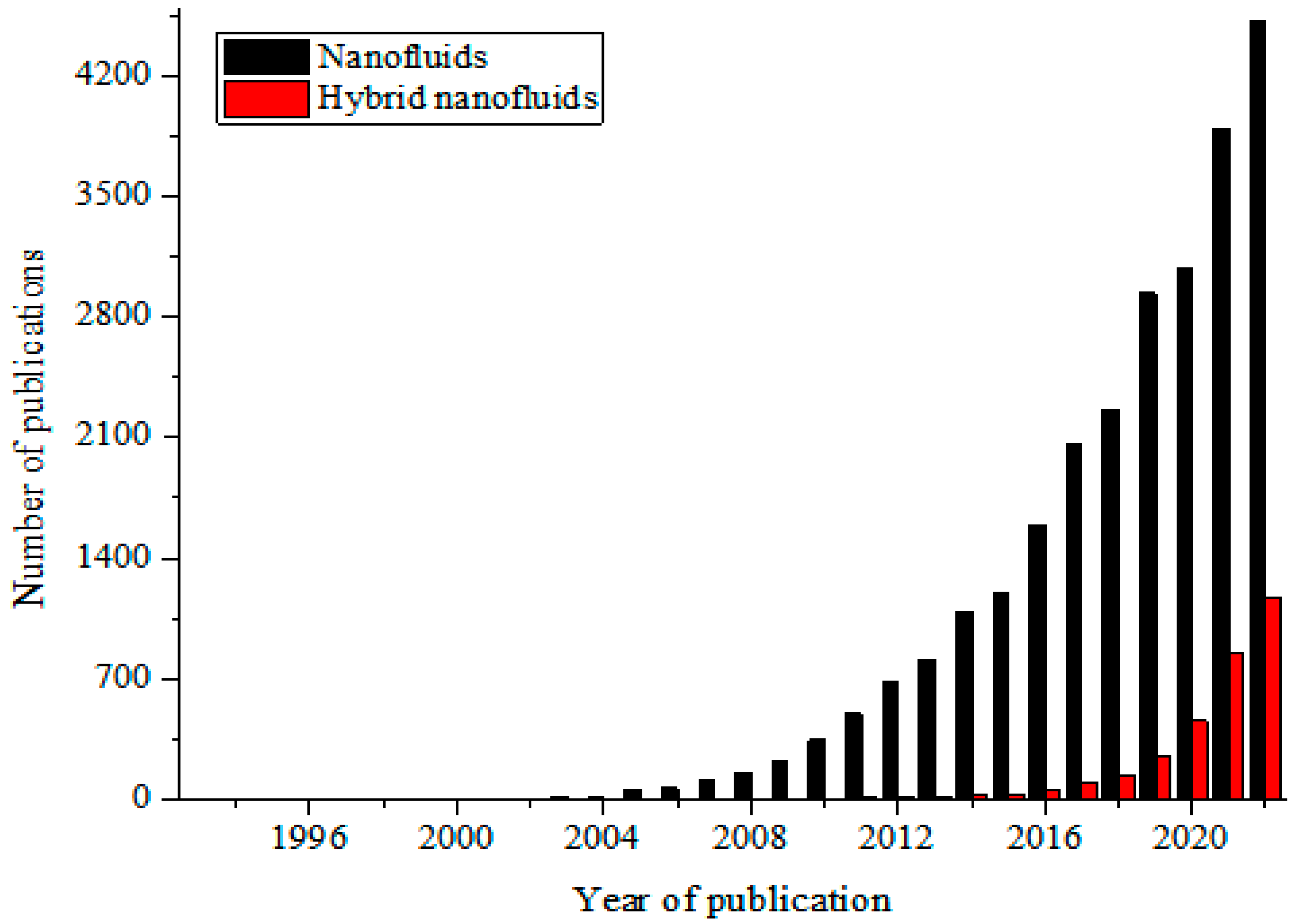

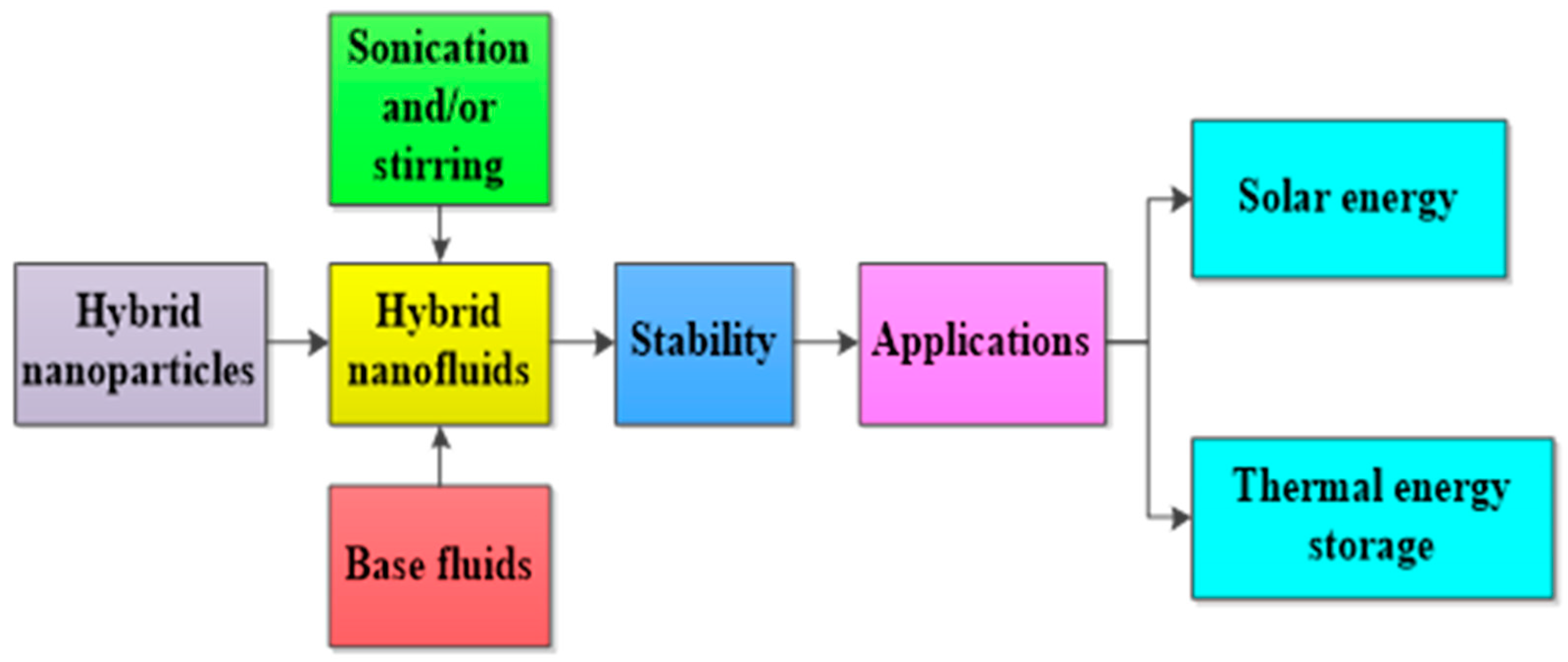
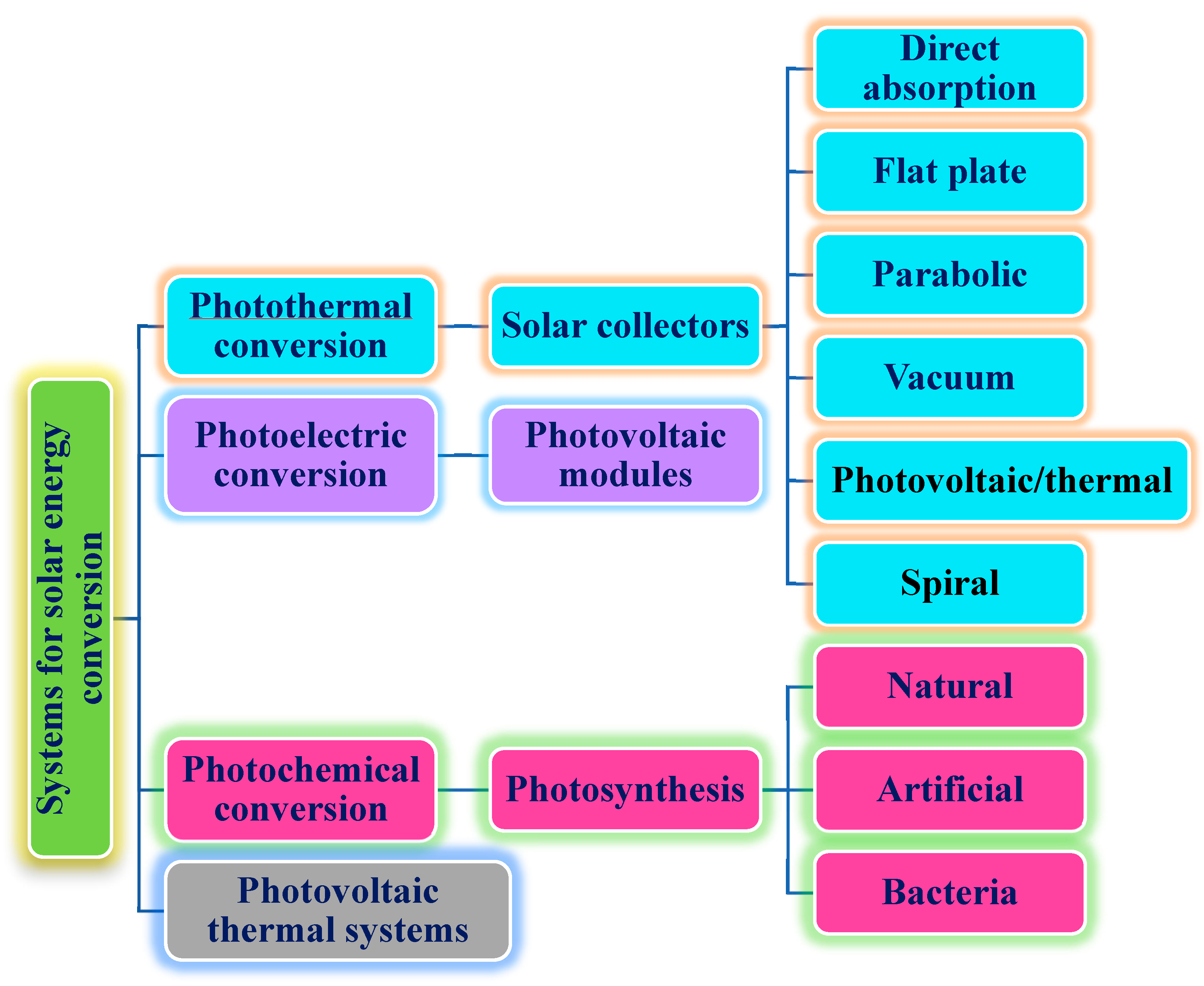
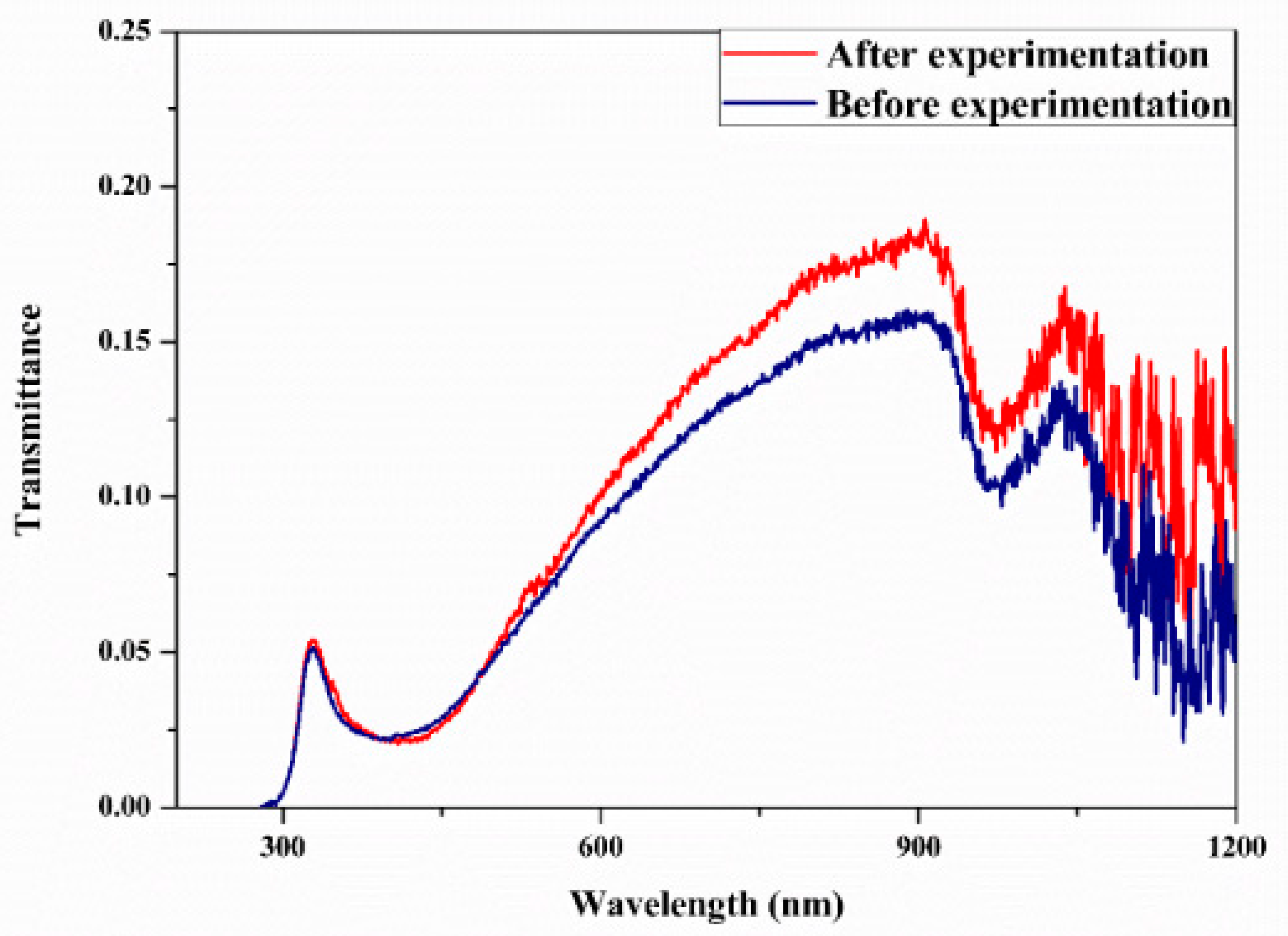
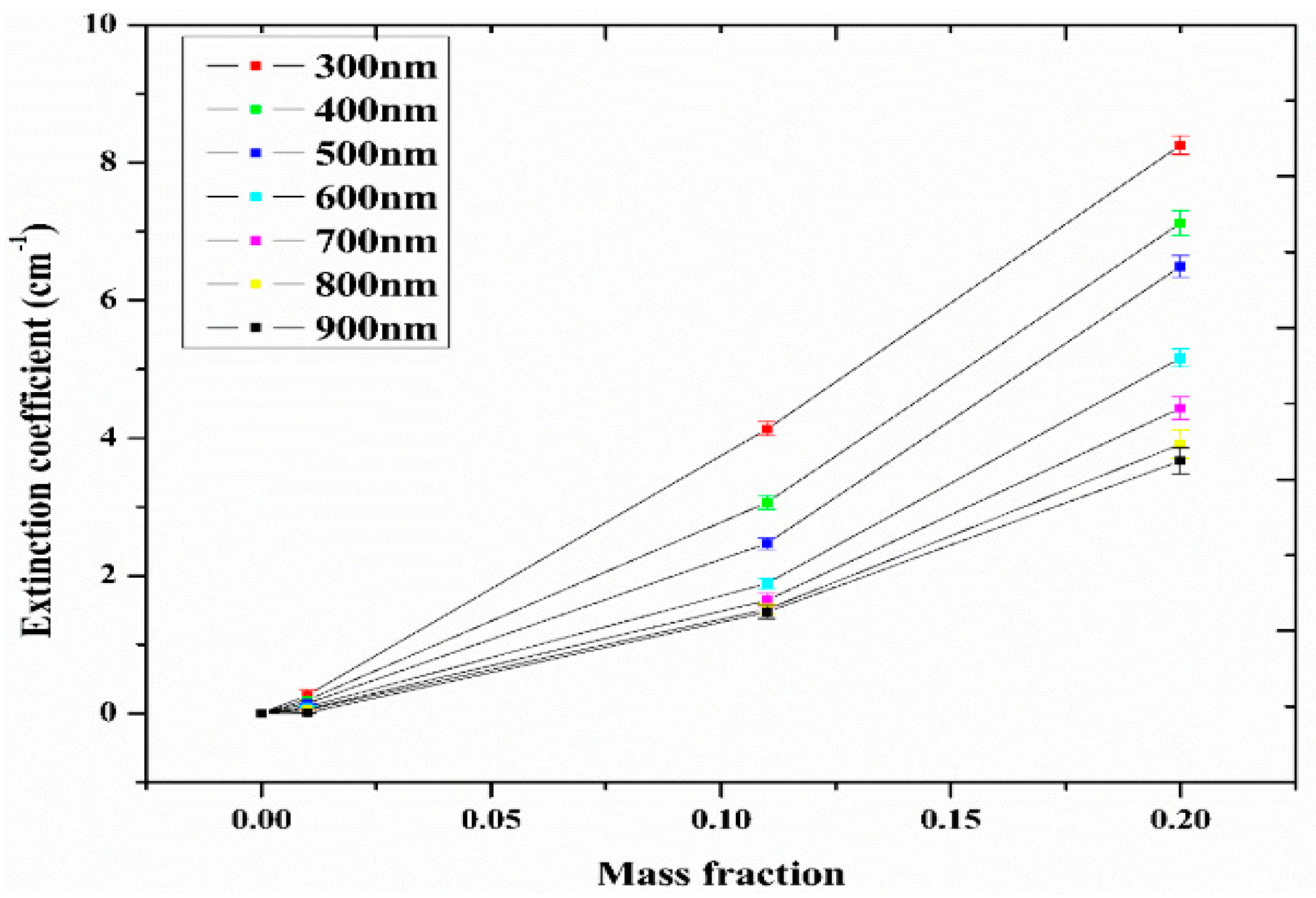
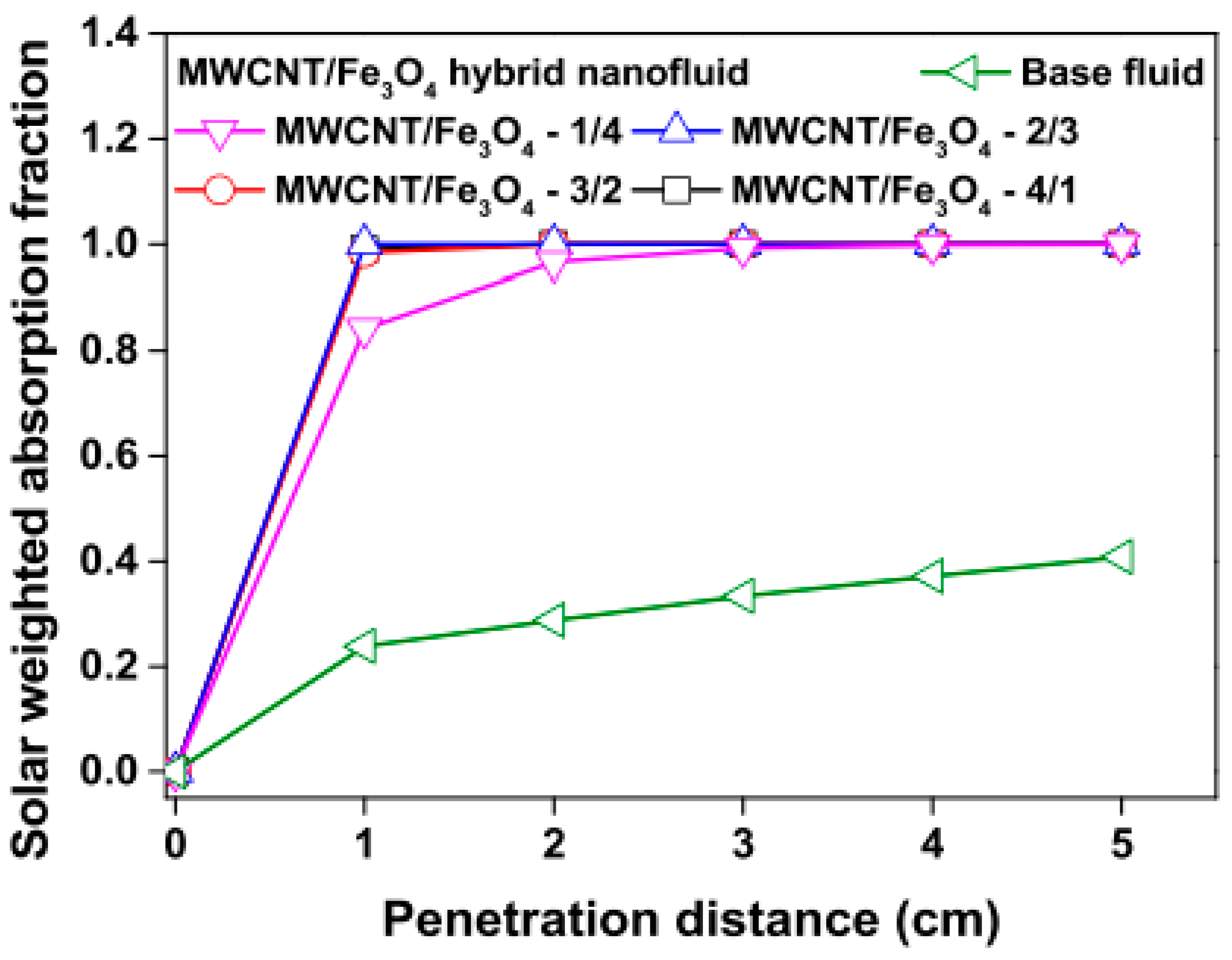
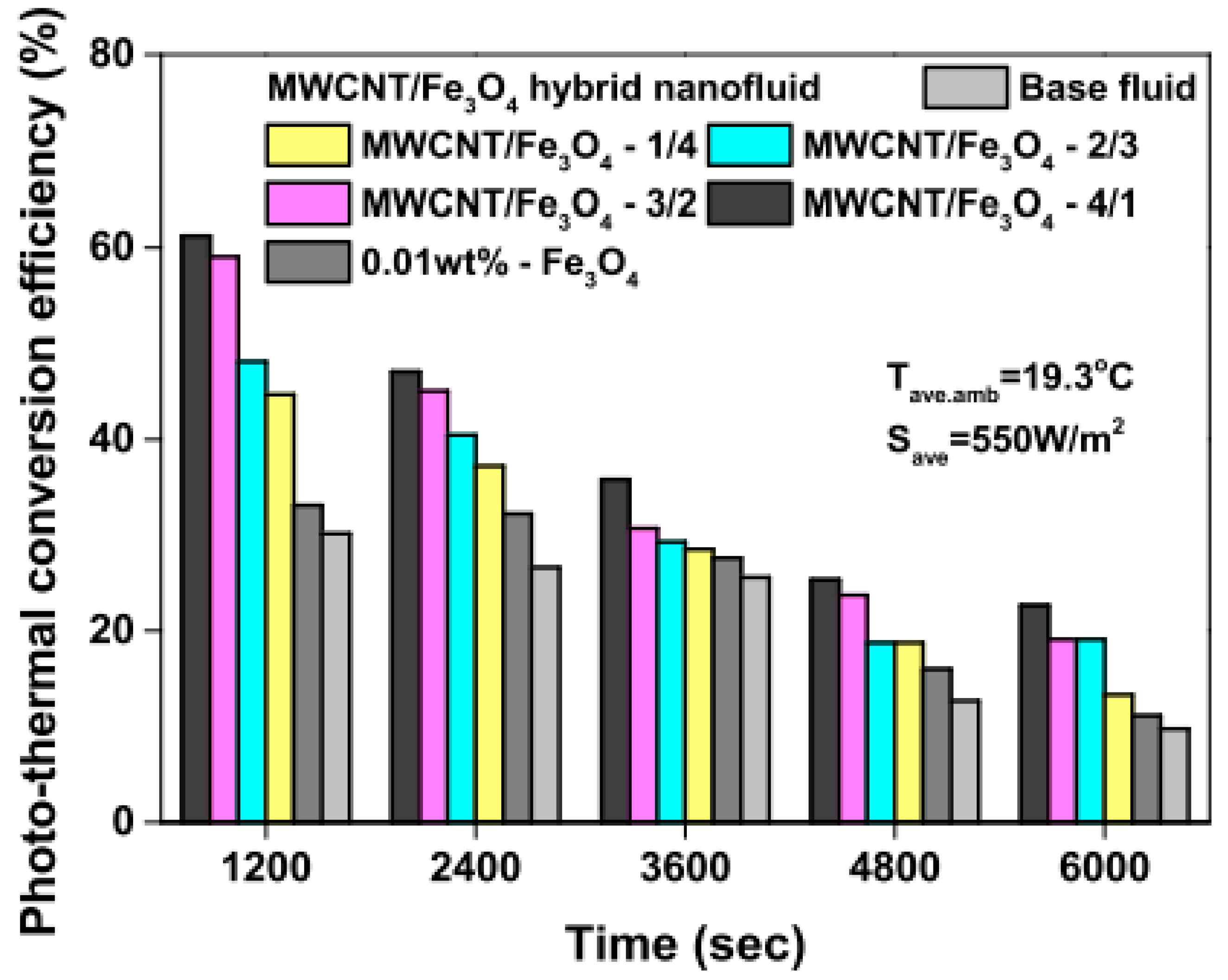
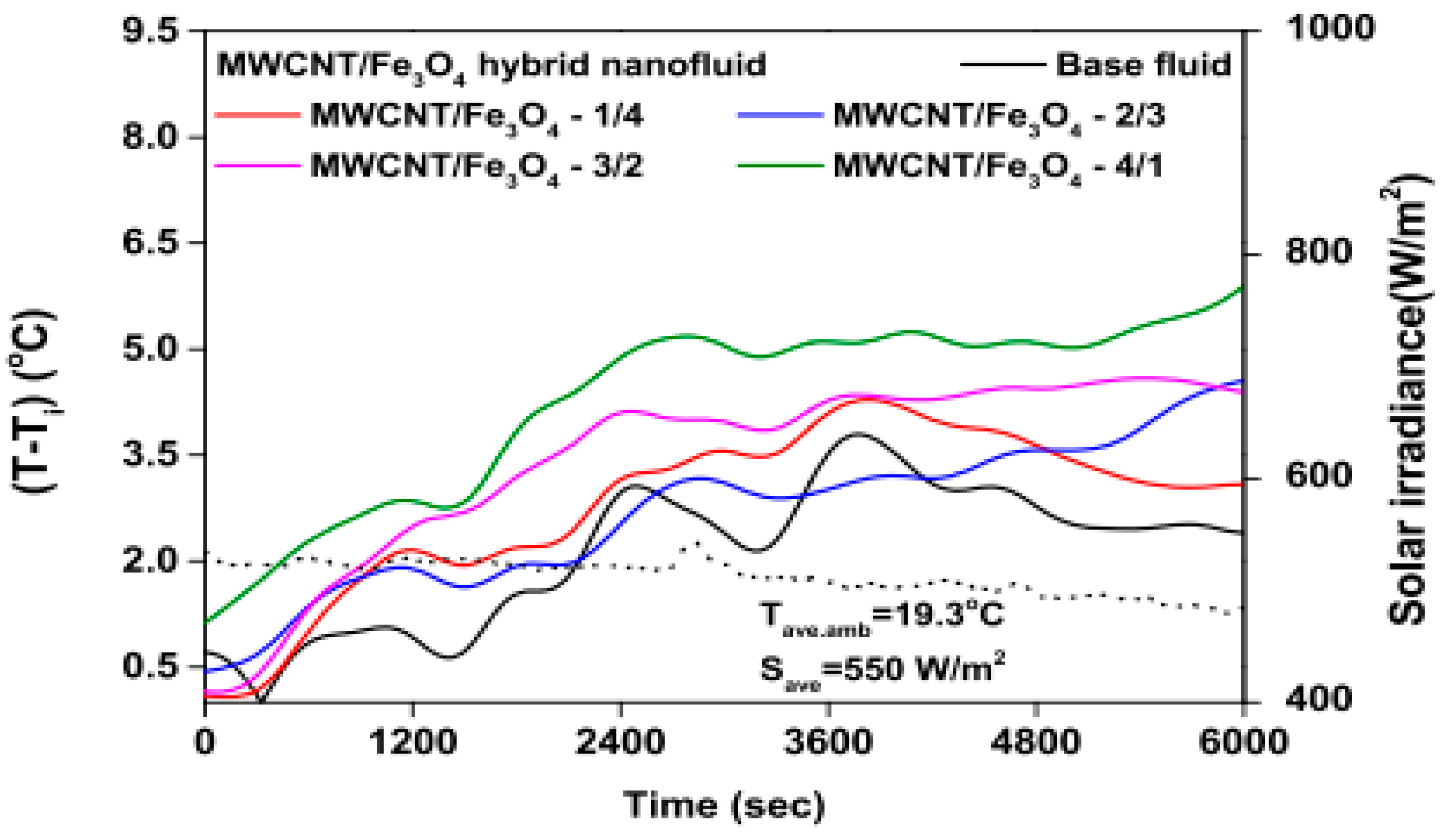

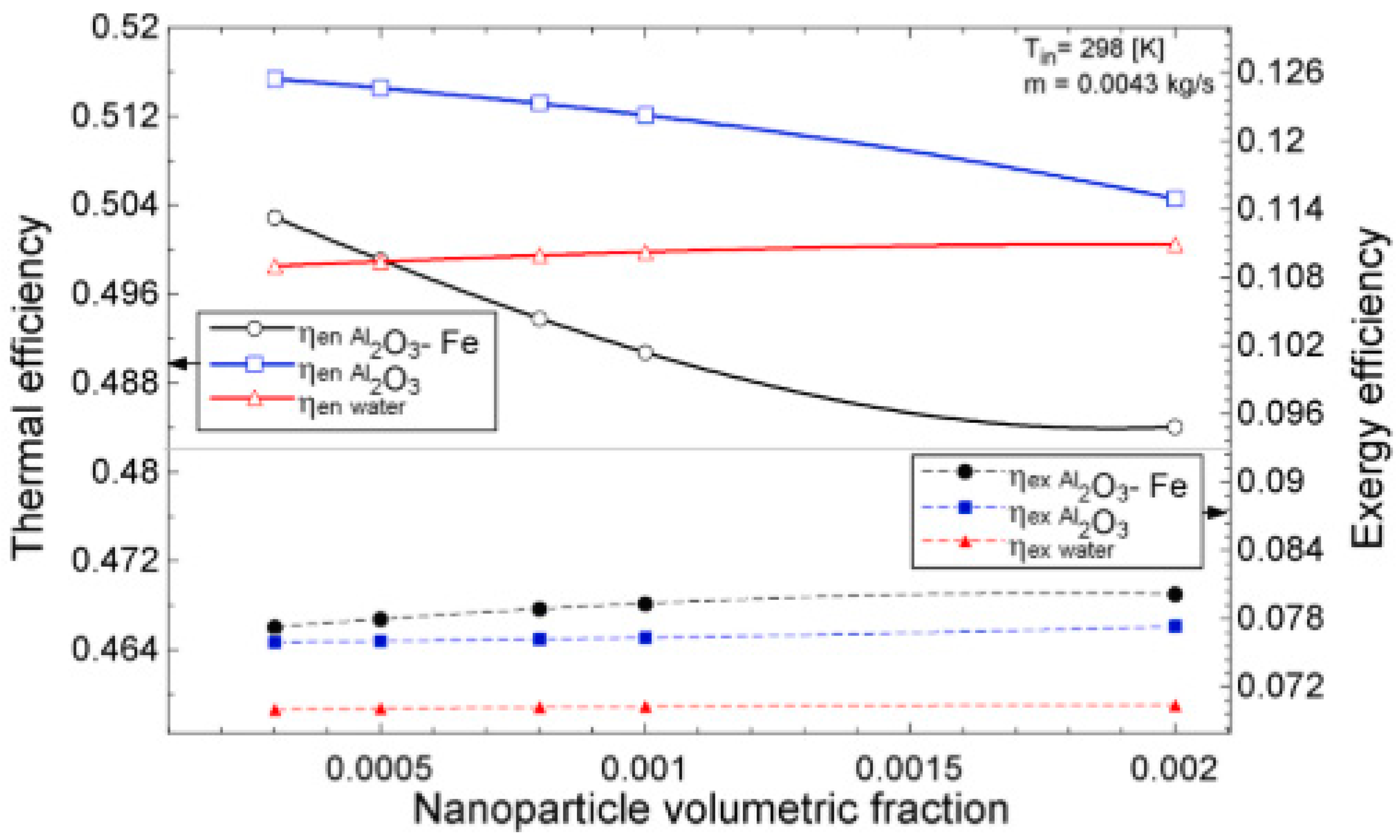



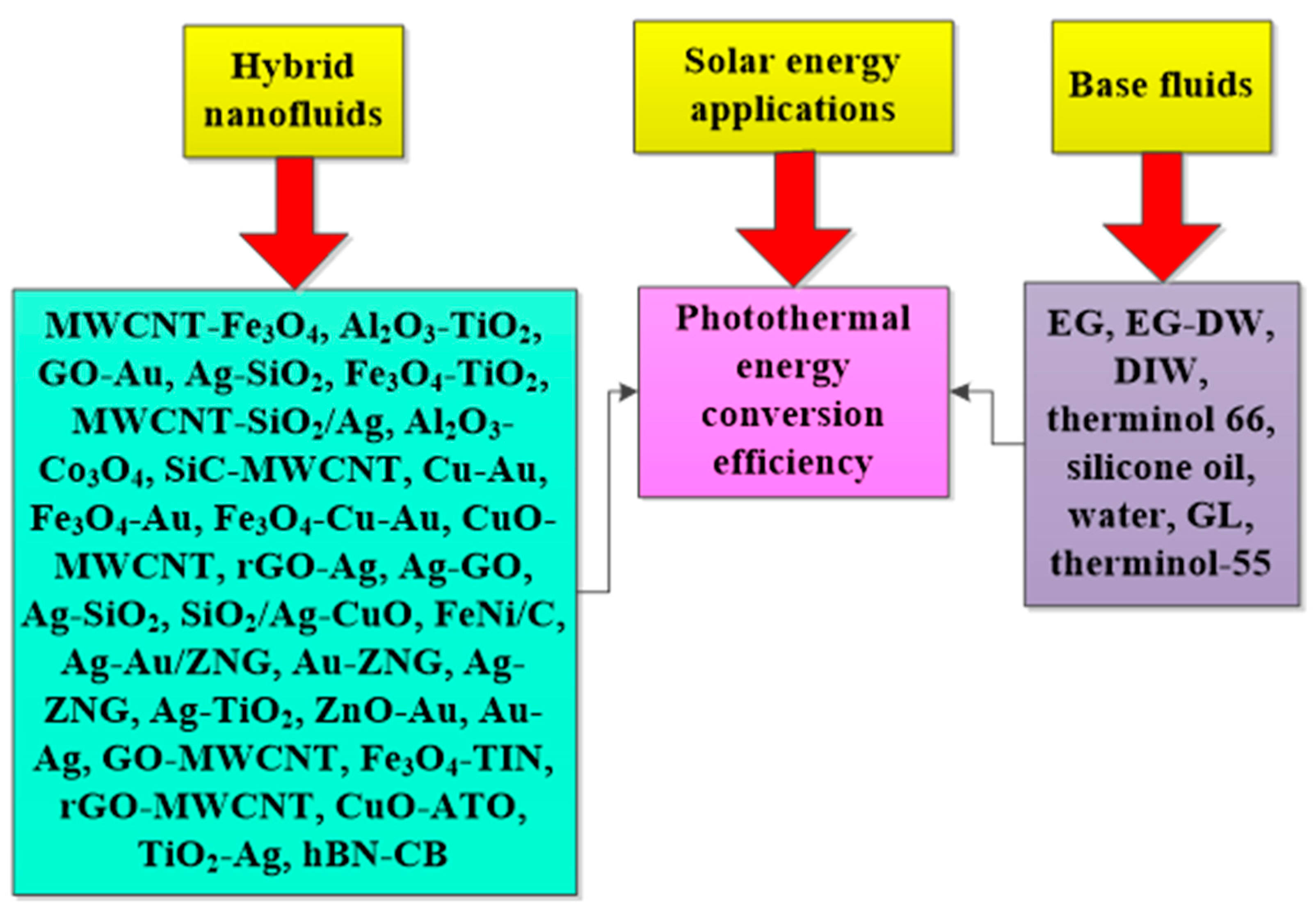
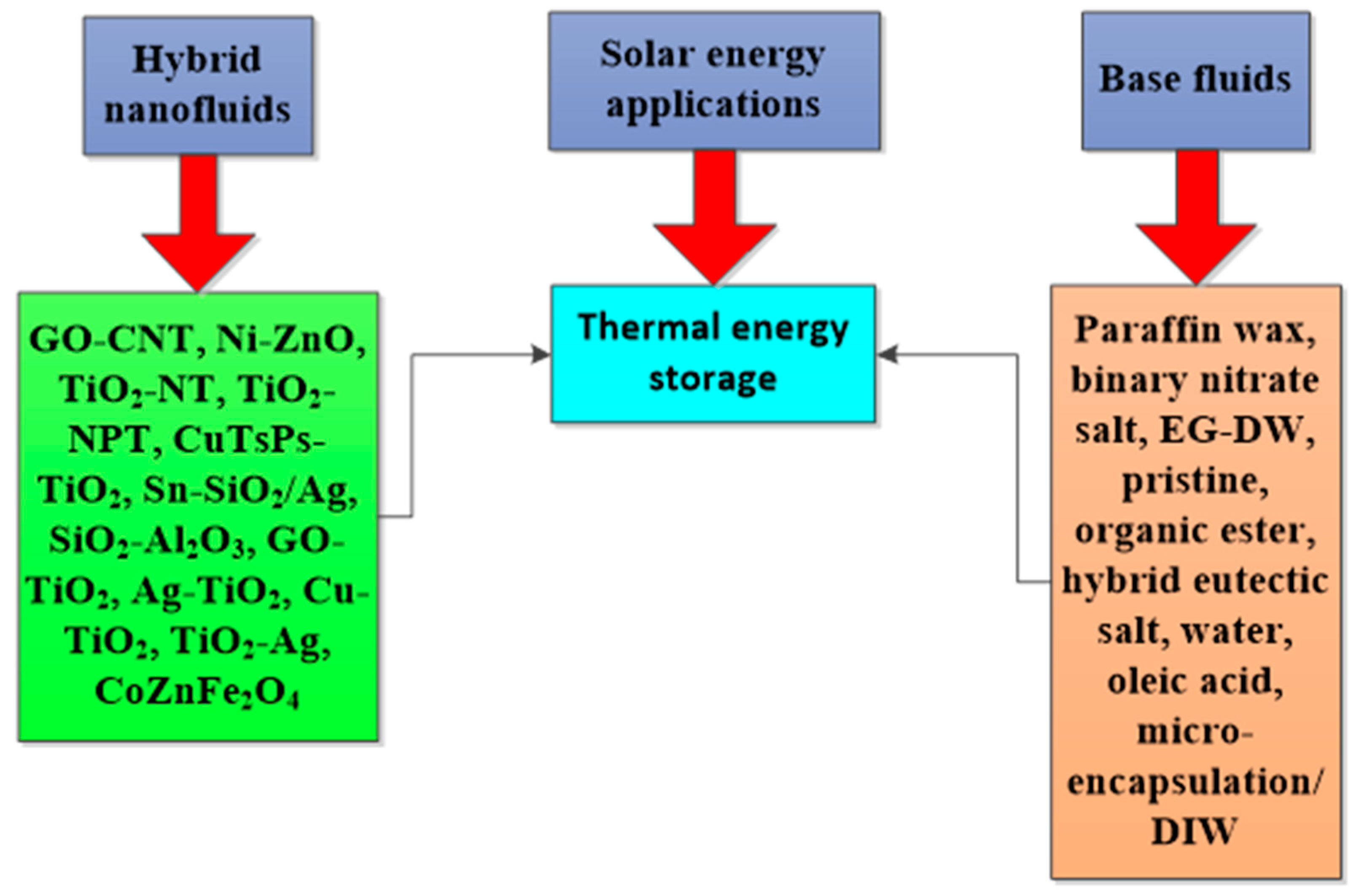

| References | HNF (Mix)/Base Fluid | φ | Collector Type | Nano-Size (nm) | Stability | Thermal Properties | Result |
|---|---|---|---|---|---|---|---|
| Okonkwo et al. [112] | Al2O3-Fe (1:1)/W | 0.05–0.2 vol% | Flat plate (φ, mass flow rate, and temperature parameter) | Al2O3-29 Fe-46 Al2O3-Fe-84 | ZP | κ, μ, and cp | With 0.1 vol%, the exergetic efficiency of MNF and HNF was enhanced by 5.7% and 6.9% while the energy efficiency was augmented by 2.16% and depreciated by 1.79%, respectively, as compared with water. The h was observed to enhance as the mass flow rate and temperature increased, with MNF (72%) recording the highest value followed by HNF (56%) and water. |
| Verma et al. [113] | MWCNT-CuO and -MgO (20–80)/DIW | 0.25–2 vol% | Flat plate (φ, mass flow rate, solar intensity, and temperature parameter) | CuO-42 MgO- MWCNT-7 | UV | κ, μ, ρ, and cp | In comparison with DIW, the energetic and exergetic efficiency of 23.47%, 9.26%, 12.65%, 18.05%, and 20.52%, and 29.8%, 12.3%, 17.1%, 23.4%, and 25.1% were obtained for the DIW-based MWCNT, MgO, CuO, CuO-MWCNT, and MgO-MWCNT NFs, respectively. |
| Bellos and Tzivanidis [114] | Al2O3-TiO2 (1.5:1.5 vol%)/oil | 3 vol% | Parabolic trough (inlet temperatures) | - | - | - | Thermal efficiency augmented with a decrease in inlet temperature while the exergetic efficiency, Nu, and h enhanced as the inlet temperature increased. Using the HNF, exergetic efficiency of 38.35% was achieved against 37.94% for MNFs and 37.68% for Syltherm 800. |
| Hong et al. [115] | rGO-Ag, rGO +Ag, GO-Ag, GO + Ag/water | - | DASCs | Ag-10–20 | UV | - | An order of rGO + Ag NFs > GO + Ag NFs > rGO-Ag NFs > GO-Ag NFs was noticed for the water mass loss, evaporation rate, and relative efficiency. At 3 runs, the relative efficiency was 73.2–91.6% for the rGO + Ag NFs with 1, 0.45, 0.225, and 0.1125 mg/mL, respectively. |
| Sreekumar et al. [63] | ATO/Ag/DIW | 0.1 wt% (optimized) | PTDASC | ATO-Ag-20–50 Ag-10 | UV, SDS, Visual (2-step) | - | Using HNF at a mass flow rate of 0.022 kg/s led to a peak thermal efficiency of 63.5% and the highest exergy efficiency of 5.6%. Optical efficiency was improved by 75% at 0°. |
| Mohan and Sajeeb [116] | CeO2-CuO (1:0–0:1)/DIW | 0.1 vol% | DASC | CeO2-30–50 CuO-30–50 | Visual | - | At a flow rate of 100 cc/min, the thermal efficiency of 13.8%, 18.1%, 24.3%, 24.9%, and 26.1% was obtained for the HNFs with mixing ratios of 1:0, 1:0.5, 1:1, 0.5:1, and 0:1, respectively, compared with DIW. |
| Lee et al. [117] | MWCNT-Fe3O4/W | 0.003 and 0.005 vol% (MWCNT), 0.01 and 0.05 vol% (Fe3O4) | Flat plate | MWCNT-20 Fe3O4-30 | ZP, Visual | - | The efficiency of water was 62.7% while those of the HNFs were 73.5–80.3% and this translated to 17.2–28.1% above that of water. The use of MWCNT (0.005 vol%) + Fe3O4 (0.01 vol%) NF produced the highest efficiency. |
| Lee et al. [117] | MWCNT-Fe3O4/W | 0.003 and 0.005 vol% (MWCNT), 0.01 and 0.05 vol% (Fe3O4) | Vacuum tube | MWCNT-20 Fe3O4-30 | ZP, Visual | - | At a mass flux of 598 kg/s m2, maximum efficiency was attained using MWCNT (0.005 vol%) + Fe3O4 (0.01 vol%) NF. The HNFs recorded an efficiency of 73.6–79.3% compared with 54.9% for water. |
| Hussein et al. [118] | MWCNT-GNP-HBN (40:60)/DIW | 0.05, 0.08, and 0.1 wt%. | Flat plate | MWCNT-15 GNP- 2 μm | UV, ZP, Tween (1:1) | μ, cp, and κ | At a flow rate of 4 L/min, the highest collector efficiency of 85% was achieved with 0.1 wt% HNF, which was 20% higher than DW. |
| Wole-Osho et al. [119] | Al2O3-ZnO (1:2, 1:1, and 2:1)/W | 0.01% and 1% | PV-T | Al2O3-29 ZnO-70 | - | μ, cp, and κ | Using an optimum mixing ratio of 0.47 of Al2O3 NPs in the HNF, the exergy, thermal, and electrical efficiency of the PV/T collector was 15.13%, 55.9%, and 13.8%, respectively. The overall maximum thermal efficiency of water-Al2O3-ZnO NF for the collector was 91%. |
| Thakur et al. [120] | Al2O3-fly ash and SiO2-fly ash (80:20)/DW | 0.5–2 vol% | Microchannel-based DASC | Fly ash-88 Al2O3-30 SiO2-60 | DLS, ZP, Sodium oleate (2-step) | μ, cp, ρ, and κ | The thermal and exergy efficiency of the collector was 72.82% and 59.23% and 73% and 68.09% for Al2O3-fly ash (80:20) and SiO2-fly ash (80:20) NFs, respectively. Pumping power of Al2O3-fly ash (80:20) and SiO2-fly ash (80:20) NFs was higher than DW. |
| Salman et al. [121] | Al-Al2O3/DW | 1%, 3%, and 5% | Vacuum tube | Al-50 Al2O3-50 | - | - | Peak thermal efficiency was >60% at a flow rate of 45 L/h and volume fraction of 5%, which was 24.89% higher compared with DW. |
| Tahat and Benim [122] | Al2O3-CuO (70:30)/EG-W (25:75 wt% | 0.5–2 vol% | Flat plate solar collector | Al2O3-40 CuO-29 | ZP (2-step) | μ, ρ, and κ | Thermal efficiency of FPSC was 42–52% as the volume fraction increased from 0.5–2% when compared with water. |
| Mendari et al. [75] | Al2O3-CuO/ EG-DW (50:50) and DW | CuO-0.001% and Al2O3-0.04% | DAPTSC | Al2O3-40 CuO-100 | UV, Visual, pH, SHMP (2-step) | Absorbance and κ | Flow rate increase reduced temperature change and outlet temperature while it increased inlet temperature and thermal efficiency. Increasing φ improved temperature change, solar irradiation, and thermal efficiency. |
| Khashan et al. [89] | Fe3O4-SiO2/DIW | 1 mg/mL and 2 mg/mL | DASC | Fe3O4- 7.8 SiO2-50 | DLS | - | After 5 min of irradiation, the photothermal efficiency of 65.6%, 85.4%, and 98.5% was attained with DIW, kerosene + 2 mg/mL Fe3O4-SiO2 NF, and kerosene + 1 mg/mL Fe3O4-SiO2 (1 mg/mL) NF, respectively. |
| Yu and Xuan [91] | CuO-Ag (8:2 and 7:3)/DIW | 0.15–0.25% | DASC | - | UV | - | At a volume fraction of 0.025% and irradiation of 7000 s, peak temperature change and photothermal efficiency of 34.1 °C and 96.11%, respectively, were reached using CuO-Ag (7:3)/DIW NF as a thermal fluid. |
| Fang and Xuan [90] | CuO-ZnO (70:30 and 50:50)/DIW | 0.001–0.01% | DASC | UV, Visual | κ | At φ = 0.01%, the maximum solar absorption efficiency of 99.47% (CuO), 98.67% and (CuO-ZnO (70:30)), and 94.78% (CuO-ZnO (50:50)) were obtained, respectively. Maximum photothermal efficiency of 97.4% (30 °C) and 34.7% (70 °C) was reported for CuO-ZnO (70:30)/DIW NFs. | |
| Farajzadeh et al. [123] | Al2O3-TiO2 (1:1)/DIW | 0.1 wt% and 0.2 wt% | FPSC | Al2O3-20 TiO2-15 | Visual, CTAB | - | The highest thermal efficiency was recorded using Al2O3-TiO2/DIW NF at a flow rate of 2 L/m and 0.2 wt%. At 0.1 wt%, efficiencies of 19%, 21%, and 26% were obtained for TiO2, Al2O3, and Al2O3-TiO2 NFs respectively, compared with DIW. |
| Qu et al. [109] | GO-MWCNT/Therminol® 66 | 10–150 ppm | DASC | GO- 0.5–5 μm MWCNT-20–30 | UV, Oleic acid | Extinction coefficient, absorbance, and transmittance. | Under indoor and outdoor conditions, the temperature of 100 ppm-GO-MWCNT/therminol®66 NF was 94 °C and 153 °C and 11.6 °C and 97 °C higher than therminol®66, respectively. The collector efficiency of 100 ppm HNF was 97% and 70%, respectively. |
| Sundar et al. [85] | ND-Co3O4 (67:33)/DW | 0.05–0.15 wt% | FPSC | - | Visual | κ and μ | At a flow rate of 1.35 L/min, peak Nu, h, f, and collector efficiency of 21.23%, 36.41%, 1.13-fold, and 59.78% were attained using 0.15 wt% ND-Co3O4 nano-coolant, respectively. A collector efficiency of 49.81% was obtained for DW. |
Disclaimer/Publisher’s Note: The statements, opinions and data contained in all publications are solely those of the individual author(s) and contributor(s) and not of MDPI and/or the editor(s). MDPI and/or the editor(s) disclaim responsibility for any injury to people or property resulting from any ideas, methods, instructions or products referred to in the content. |
© 2023 by the authors. Licensee MDPI, Basel, Switzerland. This article is an open access article distributed under the terms and conditions of the Creative Commons Attribution (CC BY) license (https://creativecommons.org/licenses/by/4.0/).
Share and Cite
Yasmin, H.; Giwa, S.O.; Noor, S.; Sharifpur, M. Experimental Exploration of Hybrid Nanofluids as Energy-Efficient Fluids in Solar and Thermal Energy Storage Applications. Nanomaterials 2023, 13, 278. https://doi.org/10.3390/nano13020278
Yasmin H, Giwa SO, Noor S, Sharifpur M. Experimental Exploration of Hybrid Nanofluids as Energy-Efficient Fluids in Solar and Thermal Energy Storage Applications. Nanomaterials. 2023; 13(2):278. https://doi.org/10.3390/nano13020278
Chicago/Turabian StyleYasmin, Humaira, Solomon O. Giwa, Saima Noor, and Mohsen Sharifpur. 2023. "Experimental Exploration of Hybrid Nanofluids as Energy-Efficient Fluids in Solar and Thermal Energy Storage Applications" Nanomaterials 13, no. 2: 278. https://doi.org/10.3390/nano13020278
APA StyleYasmin, H., Giwa, S. O., Noor, S., & Sharifpur, M. (2023). Experimental Exploration of Hybrid Nanofluids as Energy-Efficient Fluids in Solar and Thermal Energy Storage Applications. Nanomaterials, 13(2), 278. https://doi.org/10.3390/nano13020278








